How Many Steaks Are In A Beef Cow? (Our Numbers!)
You probably never learned how many steaks are in a cow. I had no clue how many steaks you could get from a whole cow until we moved to the farm.
That said, I’ll take you on a deep dive and show you exactly how many steaks you can get plus the variables that determine how many steaks you’ll get. I will also share our actual and very detailed numbers from harvesting two steers.
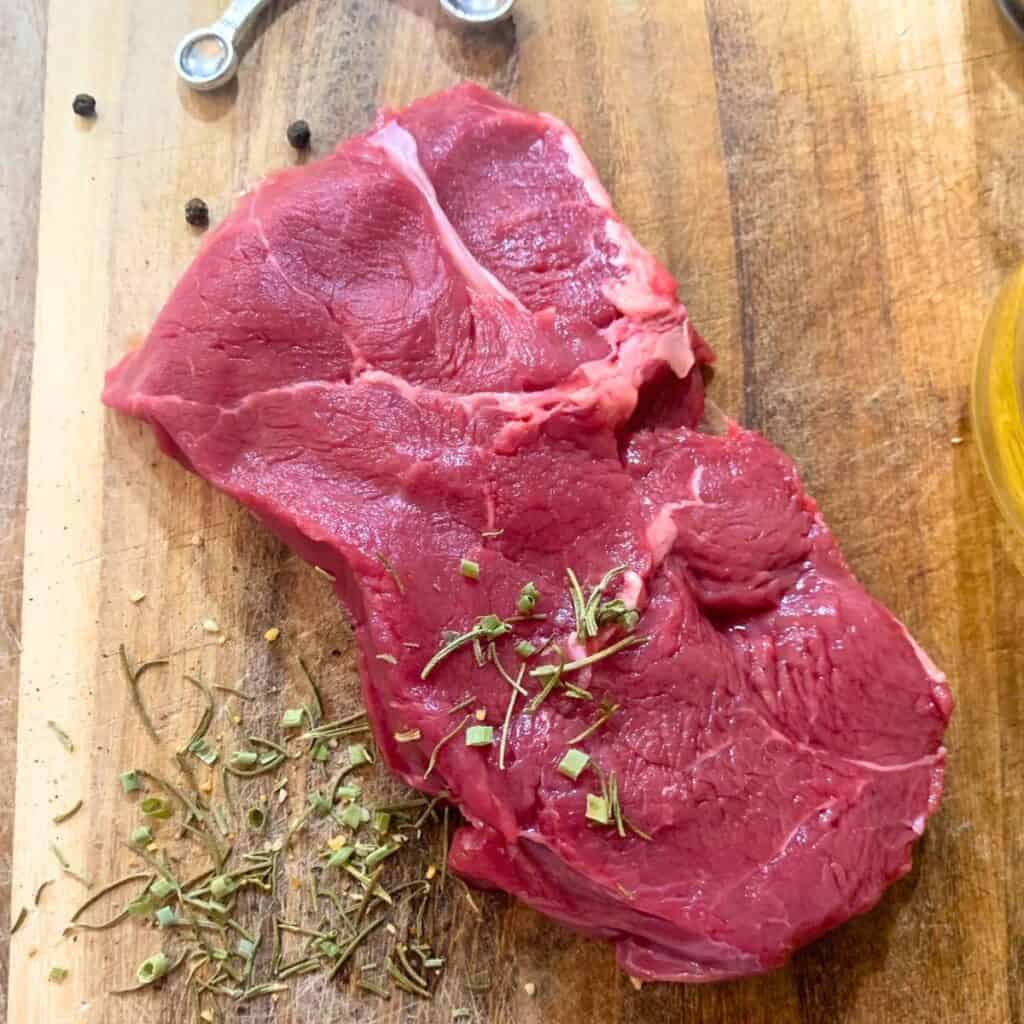
First, let’s answer the general question, “How many steaks are in a cow?”
How many steaks are in a cow?
The average number of steaks in a 1,200-pound beef cow is between 120 and 140 steaks. However, the actual number of steaks you get will vary based on the cow’s breed, genetic variability within the breed, age, frame size, gender, diet, and other variables.
The variables that influence the number of steaks you get include:
- Cow breed
- Genetics
- Age
- Frame size
- Gender
- Diet
- Processing
Let’s go into each of these variables a little deeper.
1. Cow breed influences the number of steaks you receive.
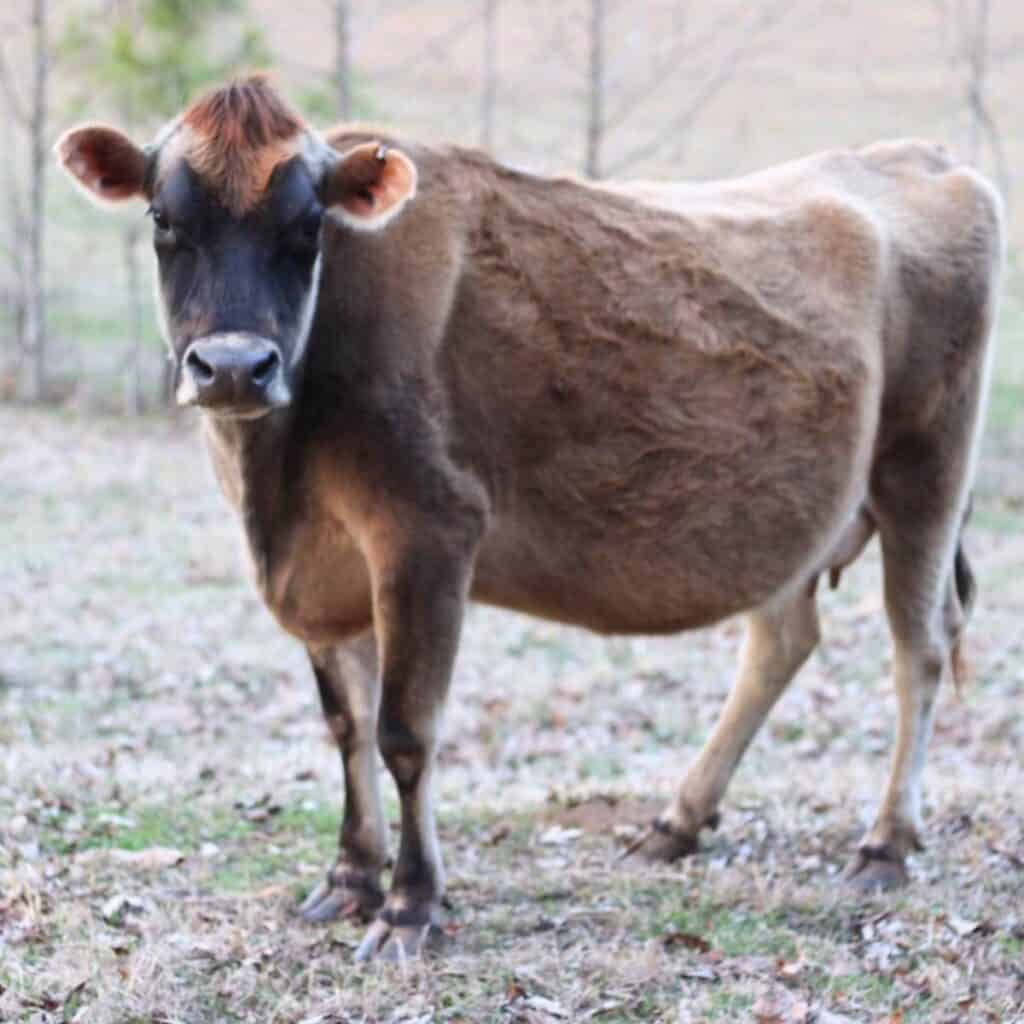
Cow breed plays an important role in determining how many steaks you will receive. For example, dairy cow breeds have less meat than standard full-size beef cow breeds.
Dairy cows produce milk and not necessarily a huge supply of beef.
If you take a dairy cow to the butcher to be harvested, you would likely get around 35% back from the hanging weight in usable beef.
Beef cows grow muscles and are good for beef production.
If you take a beef cow to your local butcher to be harvested, you would likely get around 50% back from the hanging weight in usable beef. Some beef cows even produce up to 75% in usable beef!
While there are some dual-purpose breeds of cows, most cow breeds provide either beef or milk.
2. Genetics influences the number of steaks you receive.
Genetic variability that comes from the father (sire) and mother (dam) play another important role when it comes to the number of steaks you receive.
There’s a reason why farmers and ranchers select the best fathers and mothers to reproduce. If you have a massive, healthy-looking bull mate with an equally healthy-looking female cow, the calves will be ideal beef producers.
However, if you put that same bull with a scrawny female cow, the calf will look much different and would not likely produce the same amount of beef.
3. Cow age influences the number of steaks you receive.
The cow’s age when it is harvested and processed will influence whether or not you receive any steaks, and if so, how many steaks you will receive. The age that a particular breed is fully mature and ready to be harvested varies between breeds.
You can harvest most beef cows when they reach 2 years old. However, some breeds (like the Wagyu) take 30 months to fully mature.
Taking a younger cow to the butcher will likely not result in any steaks because they haven’t reached maturity and don’t have enough fat or muscle for steaks. (Keep reading for our experience taking a young steer to the butcher.)
Likewise, the older a cow gets, the tougher the meat is, and the steaks may not be “enjoyable” to the picky foodie. A lot of times, the whole animal becomes ground hamburger. This is especially true of females, which we will touch on later.
4. Frame size influences the number of steaks you receive.
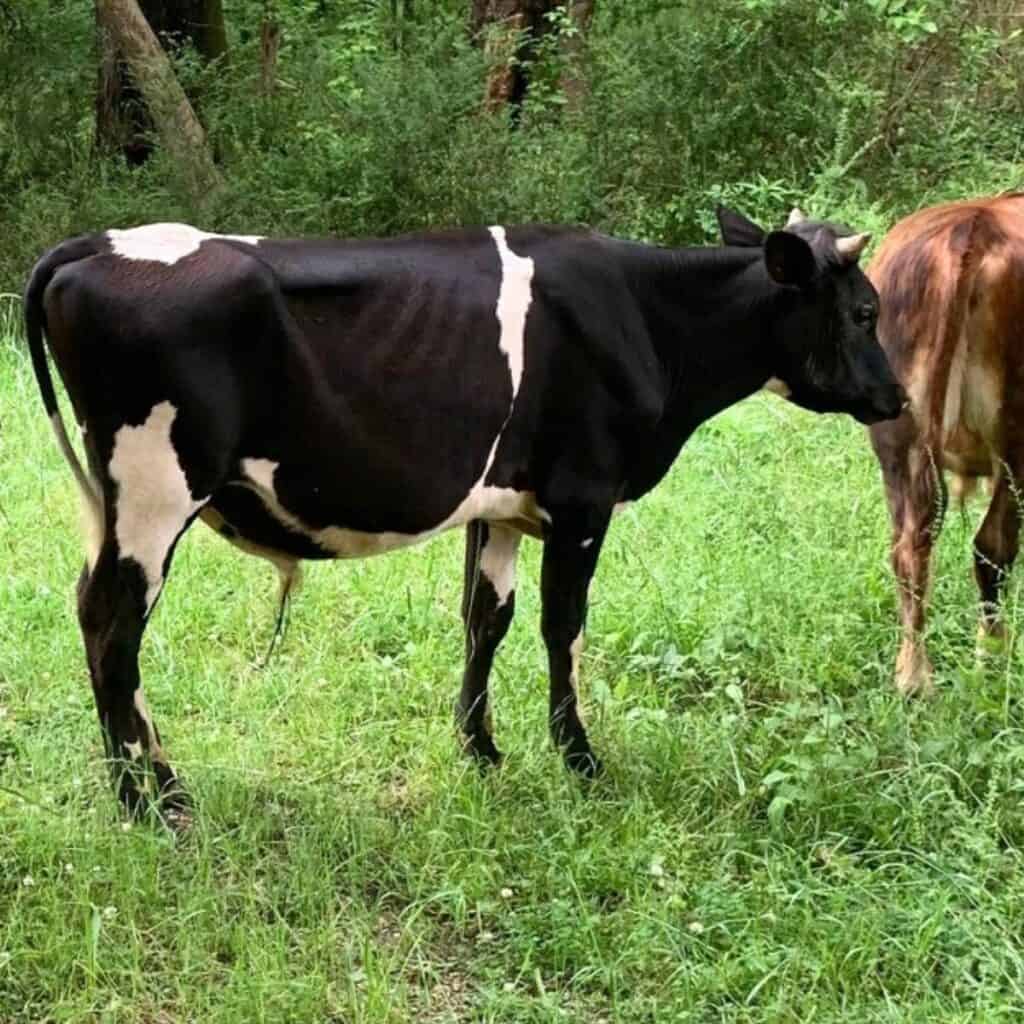
The cow’s frame size when it is harvested and processed influences the number of steaks you will receive. For example, a small-frame cow has a shorter body, which translates into fewer steaks.
In general, the shorter the cow is in both height and length, the fewer steaks you will receive.
The United States Department of Agriculture (USDA) categorized cattle by frame size (a.k.a. “grade,” “framegrade,” and “size of the cow”).
Small Frame Cattle
Feeder and stocker cattle in the small frame grade have live weights less than 1,100 pounds (500 kg). As the name implies, they are shorter and have smaller frames than the medium and large frame cattle. Choice carcasses have about one-half inch of fat (1.3 cm) at the 12th rib when they are less than 1,100 pounds.
Small frame beef cattle include American Aberdeen, Angus, Dexter, Hereford, South Poll, and Wagyu.
Note: Because genetics vary greatly between herds, the Angus can appear in all categories while the Aberdeen, Hereford, and Wagyu beef appear in only the small frame and medium frame categories.
Medium Frame Cattle
Feeder steers in the medium frame grade have live weights between 1,100 to 1,250 pounds (500 to 567 kg). As the name implies, they are slightly larger than the small frame cattle. Choice carcasses have about one-half inch of fat (1.3 cm) at the 12th rib when they reach 1,100 to 1,250 pounds.
Medium frame beef cattle include Angus, Brahman, Hereford, South Poll, and Wagyu.
Large Frame Cattle
Feeder steers in the large frame grade have live weights greater than 1,250 pounds (567 kg). As the name implies, they are larger cows with tall, long bodies. Choice carcasses have about one-half inch of fat (1.3 cm) at the 12th rib, but not until they exceed 1,250 pounds.
Large frame beef cattle include Angus, Beefmaster, Charolais, and Limousin.
5. Gender influences the number of steaks you receive.
Generally speaking, female cows have a smaller frame size and less muscle. That means that they will generally yield a smaller amount of beef.
Also, females are usually kept as breeders while the steers (males) are processed into retail cuts for grocery stores.
After keeping a female for several years and getting several calves out of her, some farms will take her to the butcher to be harvested.
However, because of her old age, she generally won’t produce the tender steaks that people are used to. Thus, she gets turned into hamburger meat most of the time.
I would just like to point out that there is nothing wrong (in my opinion) with getting the same custom cut that you would normally get from younger cows. It’s all about personal preference with the end product.
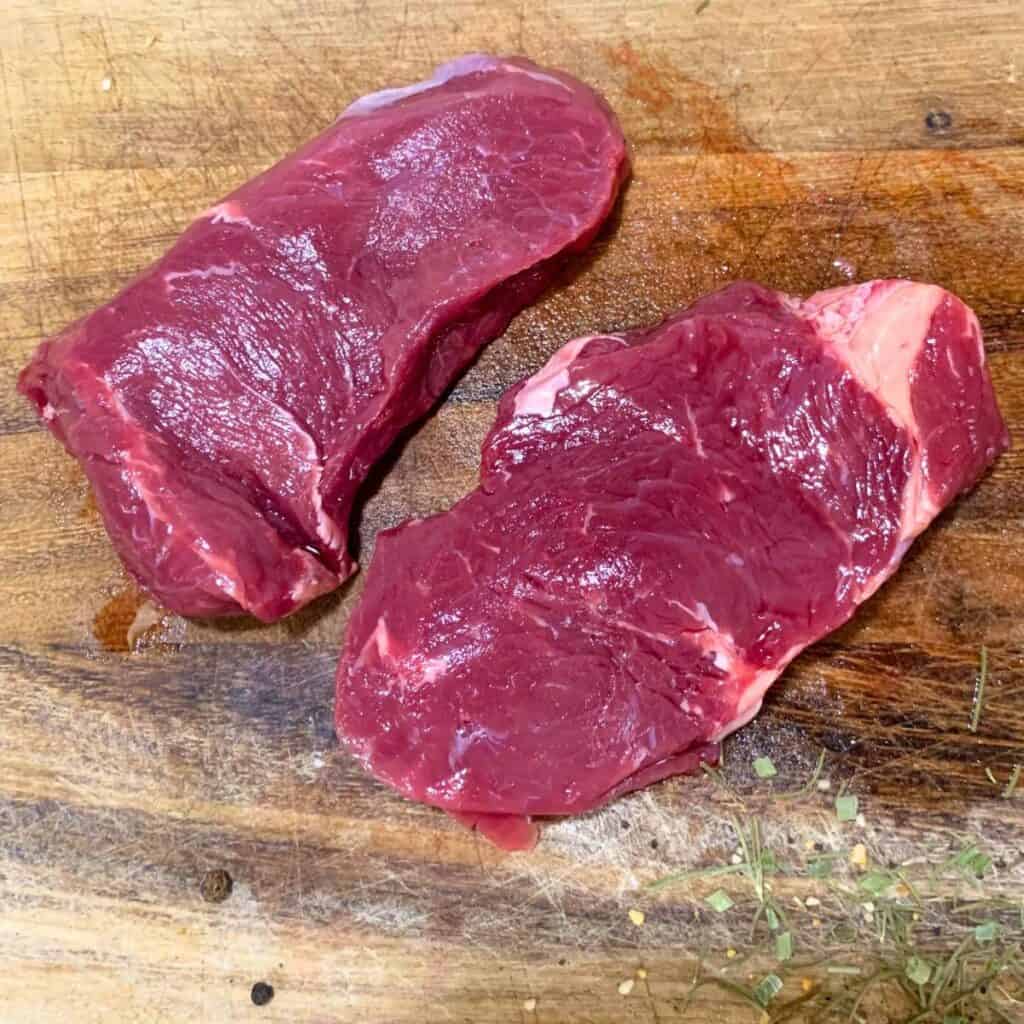
6. Cow diet influences the number and quality of steaks you receive.
What a cow eats during its life plays an important role in determining the number and quality of steaks you will receive along with other individual cuts of beef.
The live animal weight is far from what you receive back from the butcher. The cow’s live weight is reduced by half after it is harvested and hung up to age, and the hanging weight is further reduced during processing and aging until the beef is cut up and packaged. I’ll explain this more down below.
A healthy diet during the cow’s life directly influences how much beef you receive and the overall quality of the beef.
If a beef cow has a light weight or looks malnourished, it may not have enough meat on the bones to produce any steak cuts. However, if cows are able to graze for all their nutritional needs, they come from good genetic lines, and they look hefty and healthy, you will almost certainly get the type of steak you’re used to after it reaches maturity.
Grass-Finished vs Grain-Finished
This is a good spot to mention the difference between finishing a steer by feeding it grain vs 100% grass-fed beef.
When you have a fully mature cow that’s ready to go to the butcher, you can “finish it off” in two different ways.
The first option is to feed it grain (also known as “cleaning it out”) during the 60 days leading up to its harvest date. A lot of farmers enjoy the extra fat marbling (intramuscular fat) because the meat is more tender and juicy. For more on this, read the “Prime vs Choice vs Select” section below.
The second option is to let it continue eating grass, just as nature intended. A grass-fed, grass-finished cow will still produce delicious results, but there will be less fat because you didn’t give it corn in the last 2 months before harvest. Therefore, it’s more lean.

7. Processing influences the number of steaks you receive.
How you process a cow (the different cuts of meat that you order from the butcher or cut yourself) will influence the total number of steaks you will receive. The biggest factor is whether you prefer roasts or steaks.
Here are some questions that you’ll need to answer:
- Do you want roasts or steaks? (Or will you divide the cuts to get both?)
- How thick do you want each steak?
Roasts or Steaks?
The nine primal beef cuts (the first cuts the butcher makes to large sections of the cow) are chuck, rib, short loin, sirloin, round, flank, short plate, fore shank, and brisket. The butcher then makes the next cuts (also called “secondary cuts” and “subprimal cuts”). These include roasts and steaks.
When deciding between roasts and steaks, keep in mind how you cook and how your family eats. Steaks cook quickly and need high heat to sear the meat and lock in the juices. However, roasts take longer to cook because they need a low, moist heat to become the most tender and juicy.
Here are the decisions you’ll need to make, organized by the anatomy of a cow.
Chuck
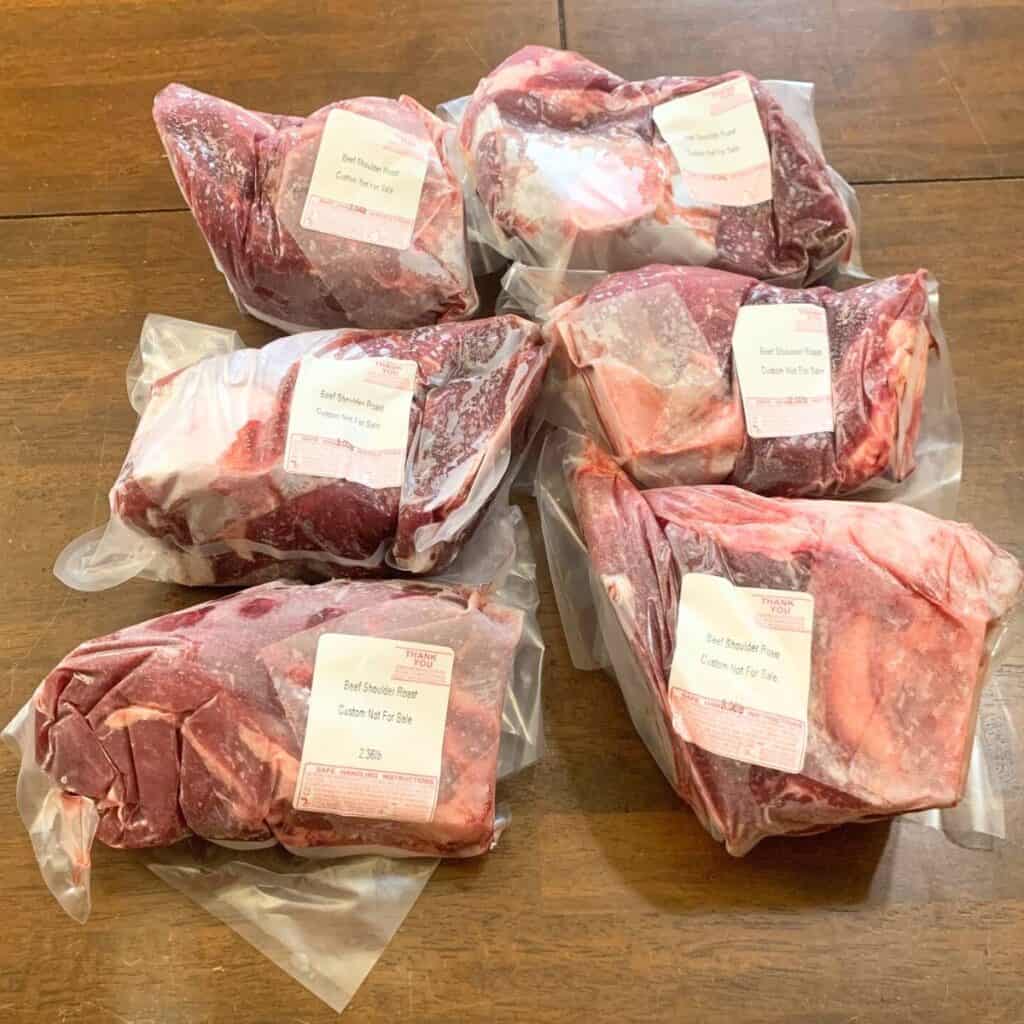
In the chuck section (right behind the head to include the top part of the shoulders, back, and neck of the cow), you have to decide between various roasts and types of steaks (or do you want some of both?).
- blade roast or shoulder top blade steak (also known as “flat iron steak” and “chuck top blade steak”)
- shoulder petite tender roast (also known as “mock tender roast”) or shoulder petite tender medallion steaks
- chuck roast (also known as “pot roast”) or chuck steak
Rib
In the rib section, you have to decide between rib roasts and rib steaks (or some of both). There are 13 pairs of ribs total.
- rib eye roast or rib eye steaks (both of these have rib bones removed)
- rib roast (from the small end) or rib steak (from the small end)
Short Loin
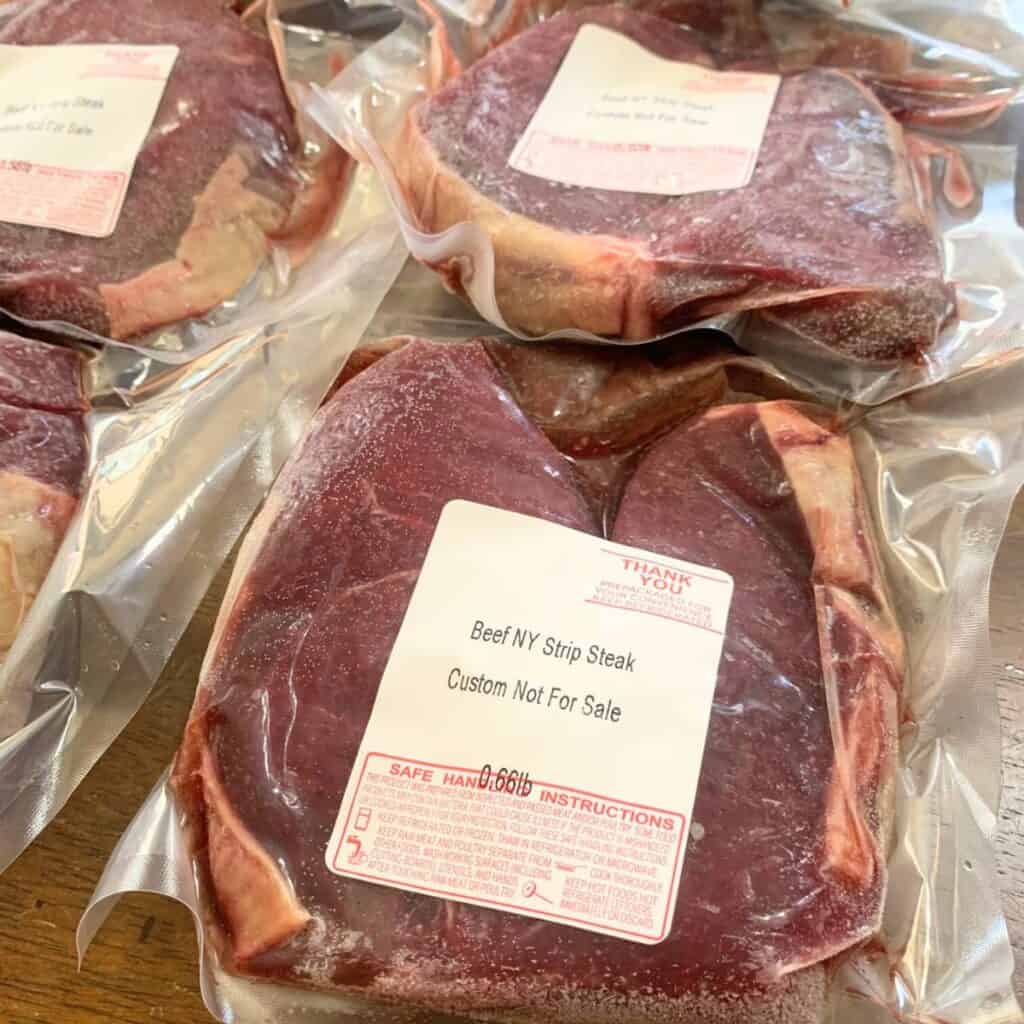
The short loin starts right after the 13th rib pair. Here are some decisions to make in the short loin section.
- tenderloin roast or tenderloin steaks (better known as “filet mignon”)
- tenderloin roast or New York strip steak
- tenderloin roast or Porterhouse steak (which includes both the filet mignon and the New York Strip steak)
- tenderloin roast or T-Bone steak (which also includes both the New York Strip steak and the filet mignon, but the filet on a porterhouse steak is generally thicker and larger than what’s included on the T-Bone steak)
Sirloin
Then you have decisions to make in the sirloin section, which is between the short loin and the round (hind end).
- top sirloin roast or top sirloin steak (also called “top sirloin cap” and “picanha”)
- bottom sirloin roast or bottom sirloin steak
When the fat cap is left on the top sirloin cap, it is called “Picanha”…which is a popular cut of beef in Brazil.
Round
Here are some decisions to make in the round section (the hind end of the cow).
- top round roast or top round steak (also called “round steak”)
- bottom round roast or bottom round steak (also called “eye round steak”)
- tip roast or tip steak
- tri-tip roast or tri-tip steak
- eye round roast or eye round steak
Flank
Then you have the flank section on the underside of the cow between the stomach and hind end (round). You don’t get any roasts in the flank section, but you can choose between ground beef or flank steak, flank steak roll, and inside skirt steak.
Short Plate
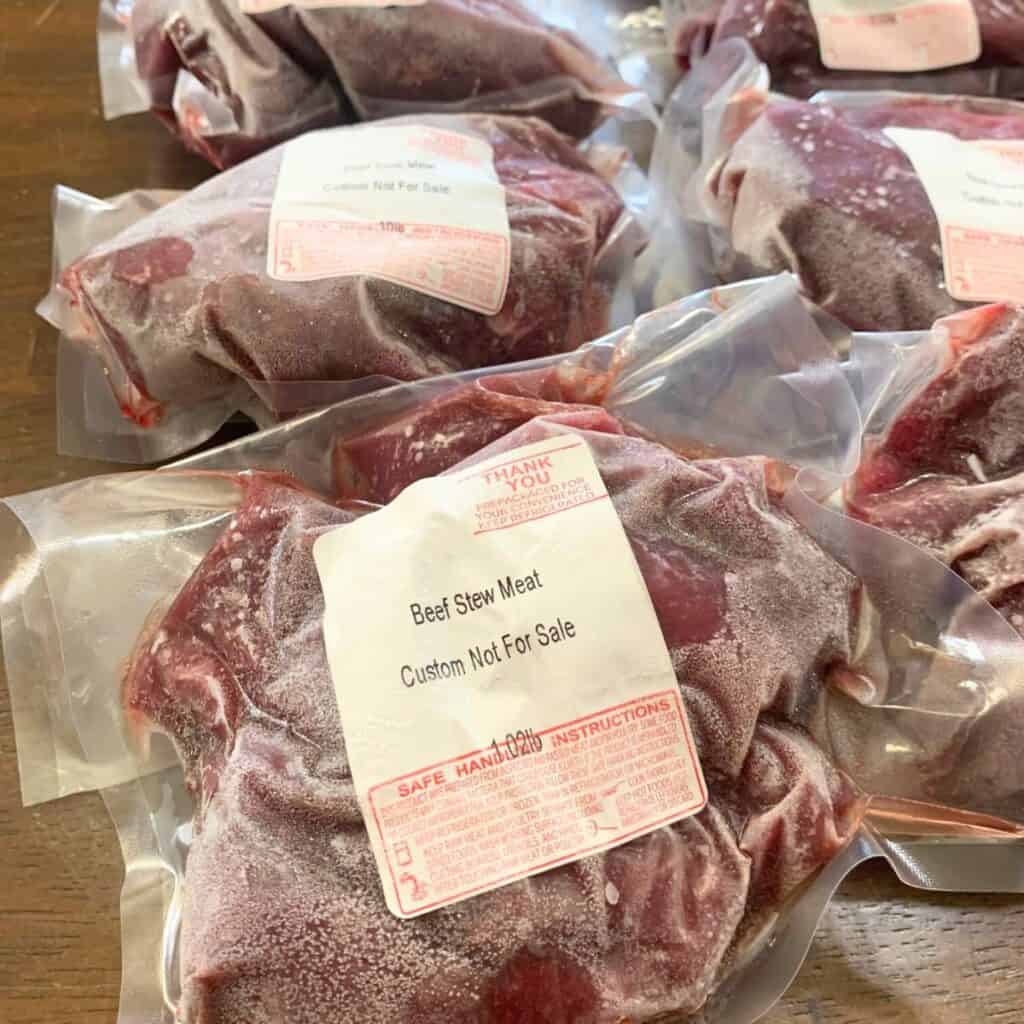
Around the stomach is the short plate section. Again, you don’t get any roasts in the short plate section, but you can choose between beef stew meat and skirt steak or hanger steak.
Foreshank and Brisket
Back at the head of the cow underneath the chuck area, you have the foreshank and brisket section, and these typically don’t have steaks cut out and only include roasts. Popular roasts in this area include beef brisket (whole, flat half, or point half) and shank crosscut.
How thick do you want each steak?
If you want to get as many steaks as possible out of a cow, then you also need to decide how thick you want your steaks cut. How thick you want your steaks is a matter of personal preference. However, you’ll get twice as many half-inch-thick steaks than one-inch-thick steaks.
Cut your steaks to 3/4 inches thick for a happy compromise.
Some Common Beef Cow Breeds
American Aberdeen
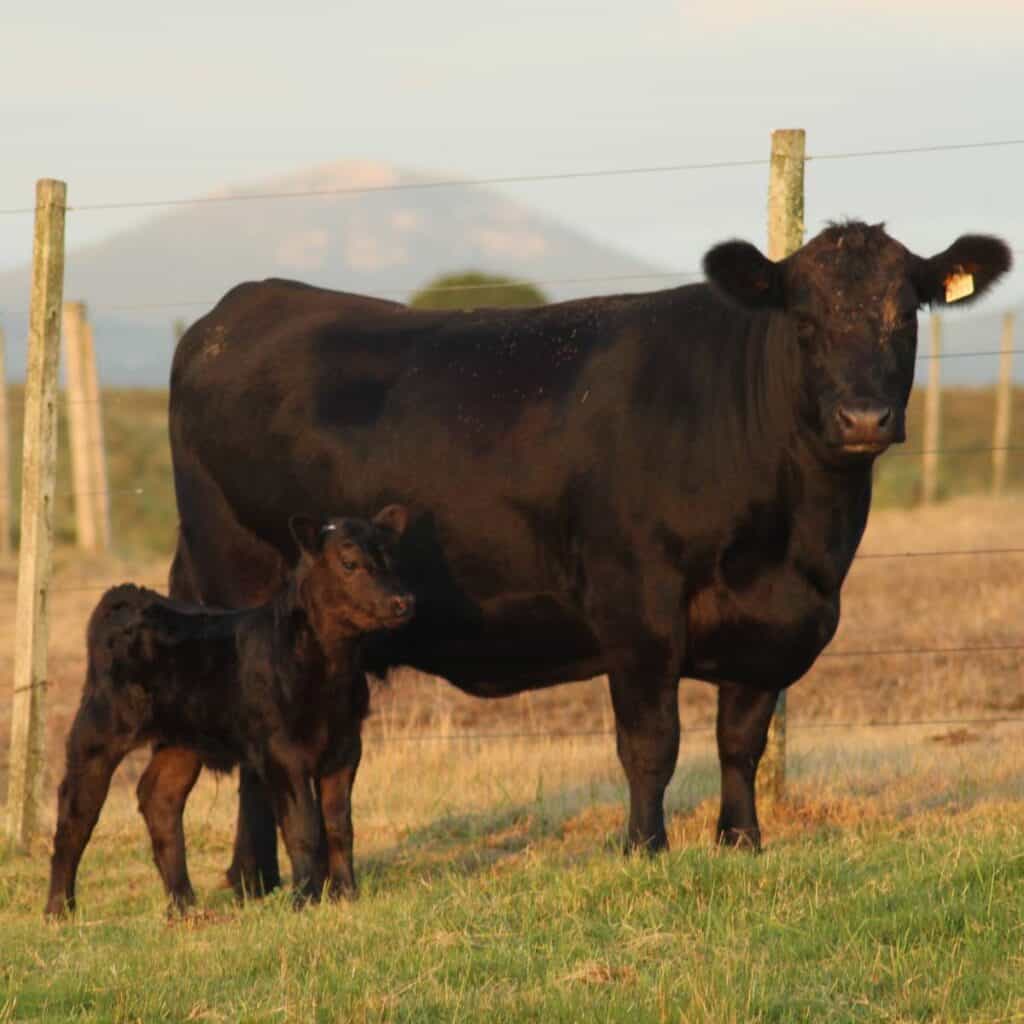
Aberdeens are also called “Lowline” and “the original Angus.” These small to medium-frame cattle are predominately black, but some are red. Aberdeen are also naturally polled (born without horns). A mature steer can weigh up to 850 pounds (385 kg).
Aberdeen cattle are docile, very fertile, excellent mothers, and superior grazers for grass-fed and grass-finished beef. Steers also mature quicker than other breeds and are ready for harvest between 18 to 24 months old.
One exciting fact about Aberdeen cattle is that they are more efficient at converting grass to edible meat. So you can expect up to 75% back from the hanging weight in usable beef!
Angus
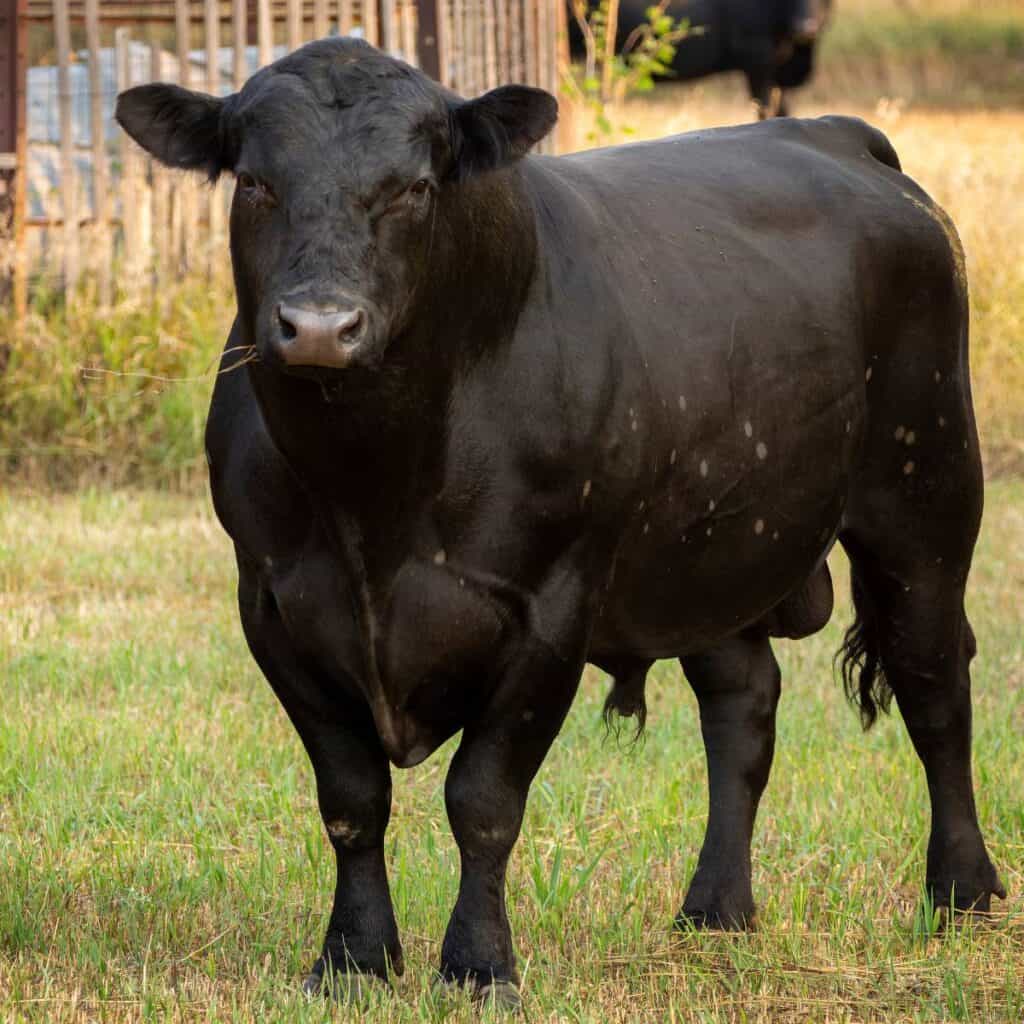
Red Angus and Black Angus cattle are naturally polled. They can also have either a small frame, medium frame, or large frame (depending on their genetics). A mature steer generally weighs between 1,000 to 1,300 pounds (450 to 600 kg).
Angus cattle are great at foraging, and they are also very disease-resistant. They can be a bit wild, though.
Beefmaster

This large frame breed was originally a mixture of Brahman, Hereford, and Milking Shorthorn. On average, Beefmaster steers weigh around 1,350 pounds (600 kg) when they are fully grown. They are light to dark red, sometimes with white mottled faces.
They have a balanced mix of the “Six Essentials” (i.e. weight, conformation, milk production, fertility, hardiness, and disposition).
Brahman
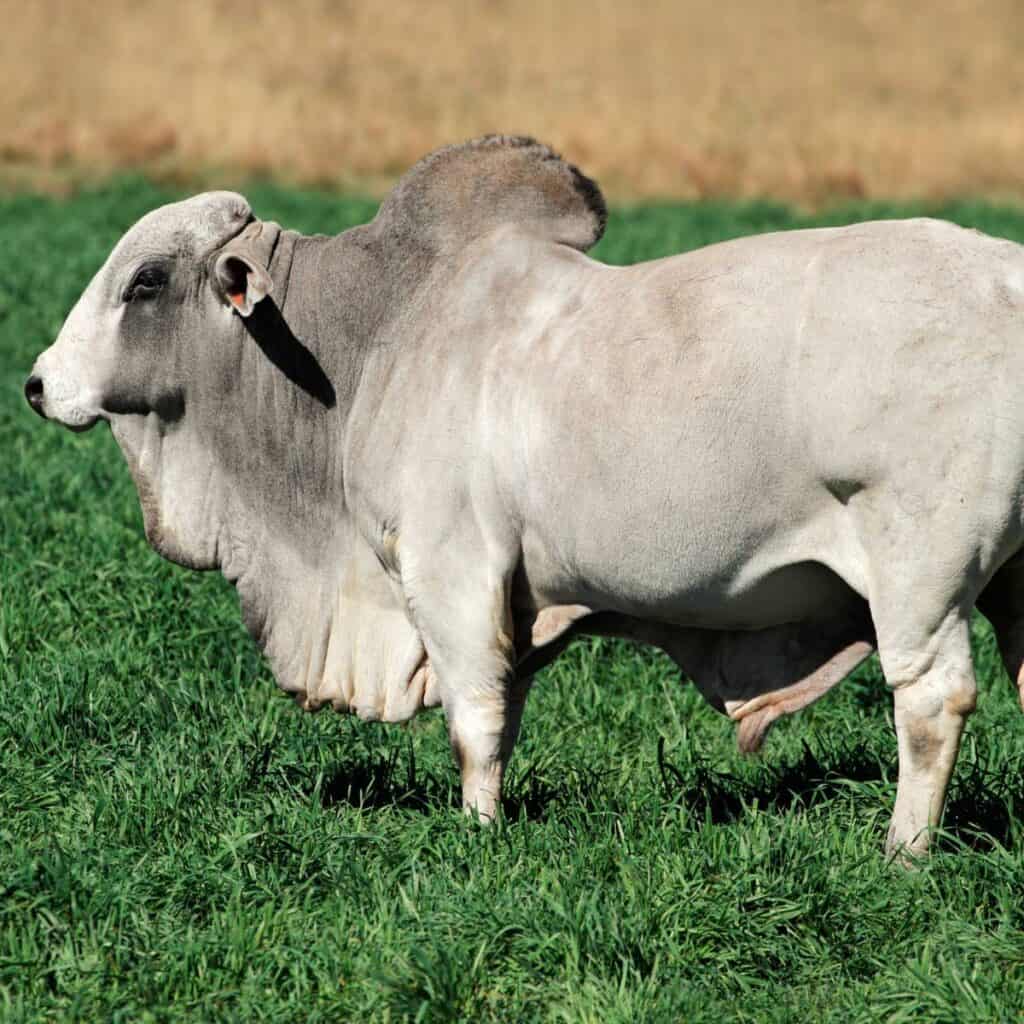
Brahman (sometimes called “American Breeds”) are medium frame dual-purpose beef and dairy cattle that can be any color or pattern. They have a large hump on their back at their shoulders, which they are famous for. On average, a fully grown Brahman steer weighs around 900 pounds (400 kg).
Thanks to their loose skin and oil glands, Brahma can withstand hot, humid climates (up to 105 degrees Fahrenheit), and they can repel some pests. They are often used to breed with other beef cows to create hybrids that can tolerate hot climates including Brangus, Beefmaster, Braford, ChaBray, and SimBrah.
Charolais
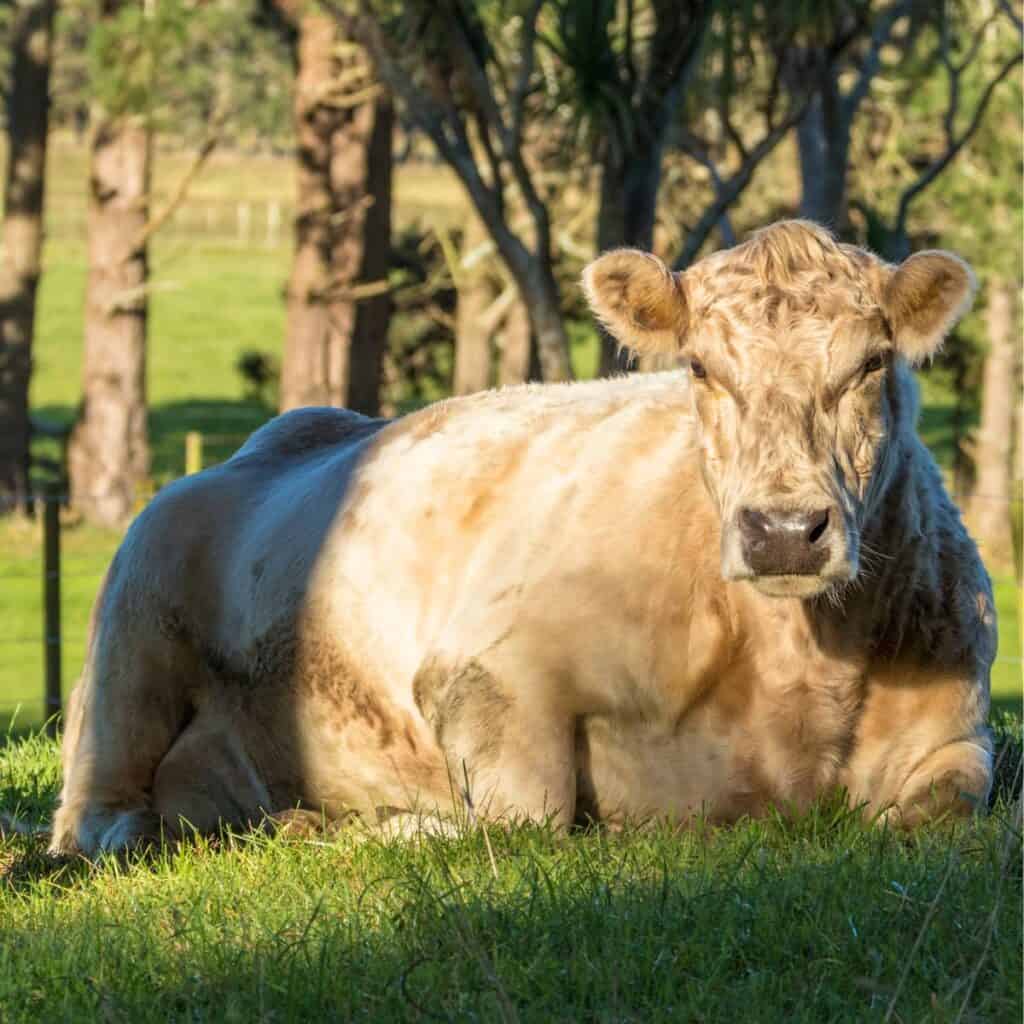
Charolais are strikingly beautiful white to creamy yellow cattle with a medium to large frame, long bodies, and lots of muscle. On average, a fully grown steer weighs around 900 pounds (400 kg), and you can generally expect 57% back in edible beef from the hanging weight.
They are born with or without horns, and they are excellent at foraging, docile, and they can withstand both warm and cold climates.
Dexter
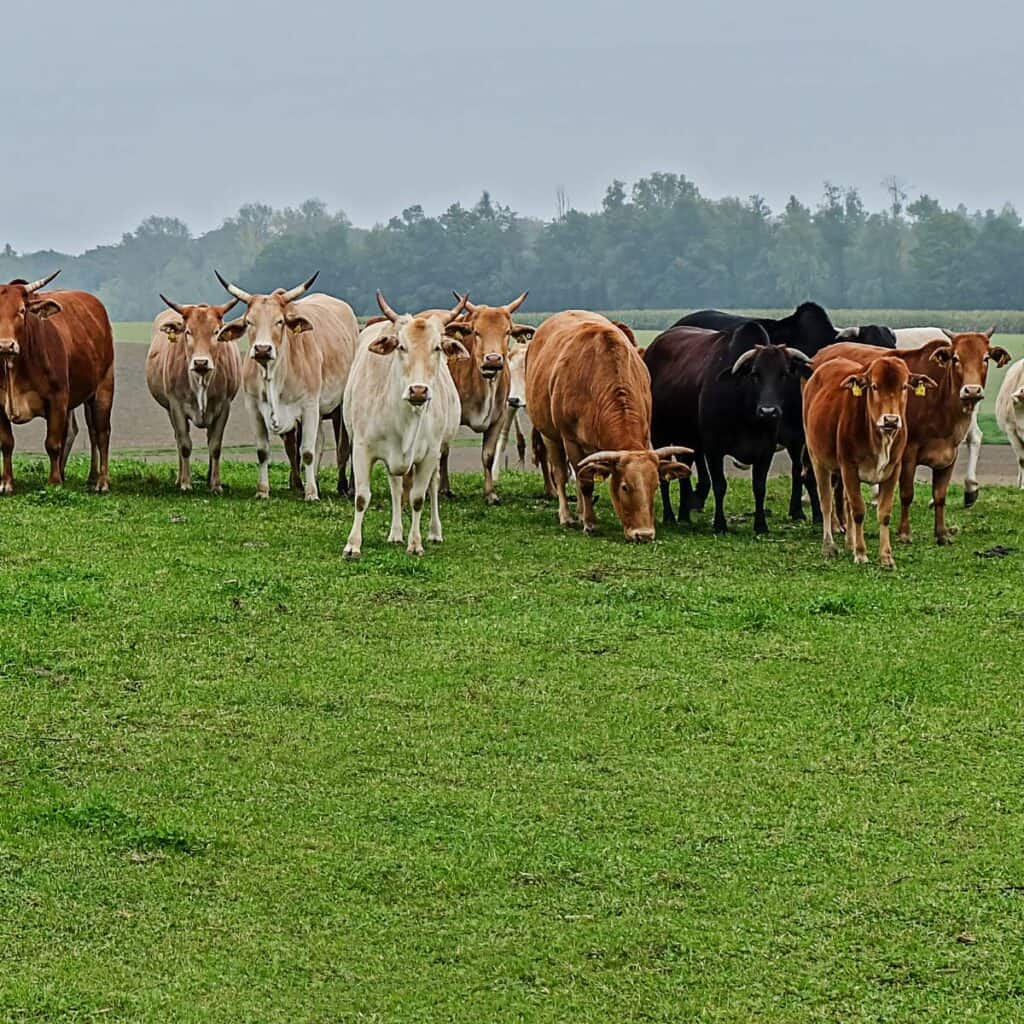
Dexters are some of the smallest, albeit productive, cattle in the world. These small frame cows are dual-purpose in that they provide milk and beef. They are most often black but can also be red or dun.
A Dexter steer will weigh about 800 pounds (360 kg) at 18-20 months, and the edible beef from the hanging weight is about 55 to 60%! Because of their small size, they’re perfect for small acreages and they won’t tear up pasture.
Hereford

Herefords can either be polled or have horns, and they are dark red to yellow with white faces. They can also have either a small frame or medium frame body.
A fully grown steer can get up to 1,000 pounds (450 kg). What they lack in size, they make up for in foraging ability and at converting grass into body mass.
Limousin
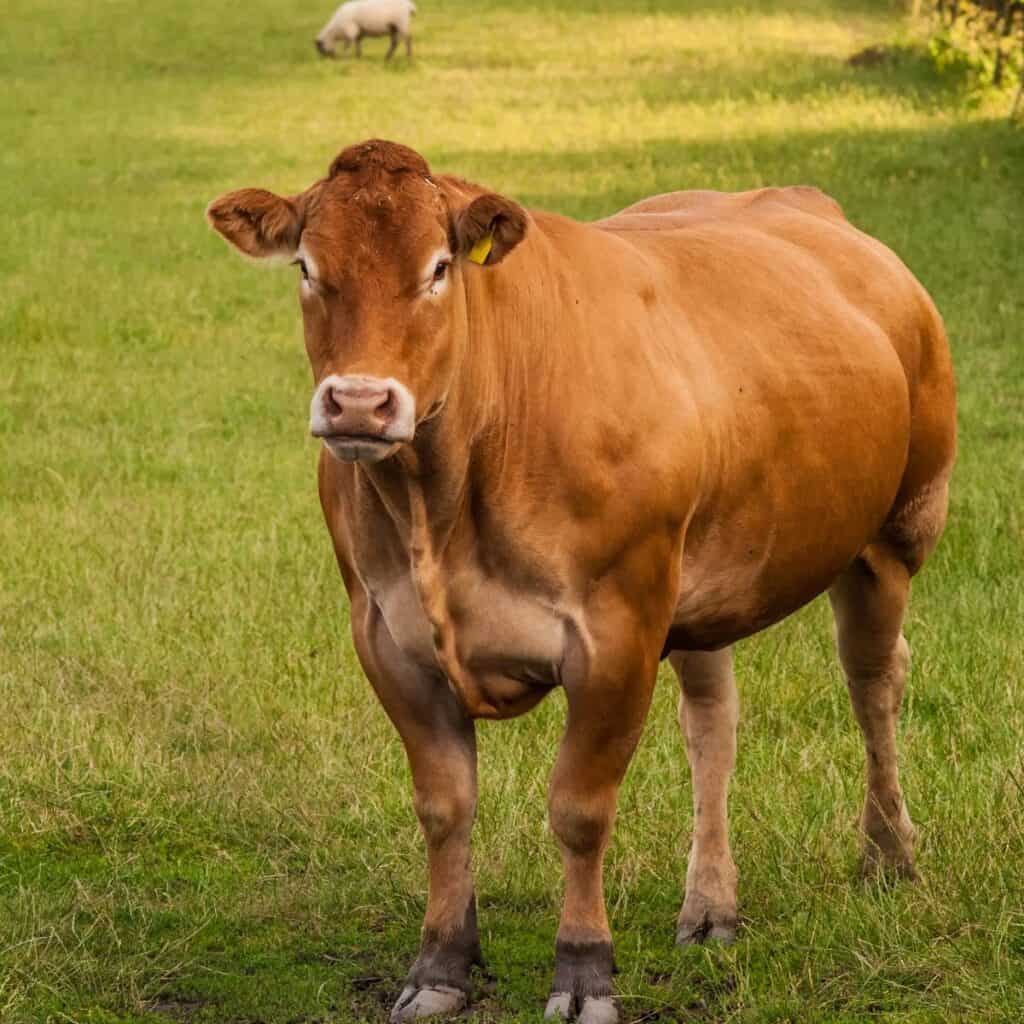
Limousins were originally bred near Limousin, France, but you can find them throughout the United States now. These large cattle are golden to medium red, and they have huge bodies and muscles.
A fully grown steer can weigh up to 1,400 pounds (650 kg) and produce over 70% edible beef from the hanging weight!
Scottish Highlands

Highlands have horns resembling Longhorns. But these small to medium-frame cattle also have shaggy, long hair, which makes them hardy for cold weather climates and offers some protection from predators.
A fully grown steer can weigh up to 1,000 pounds (450 kg).
Simmental
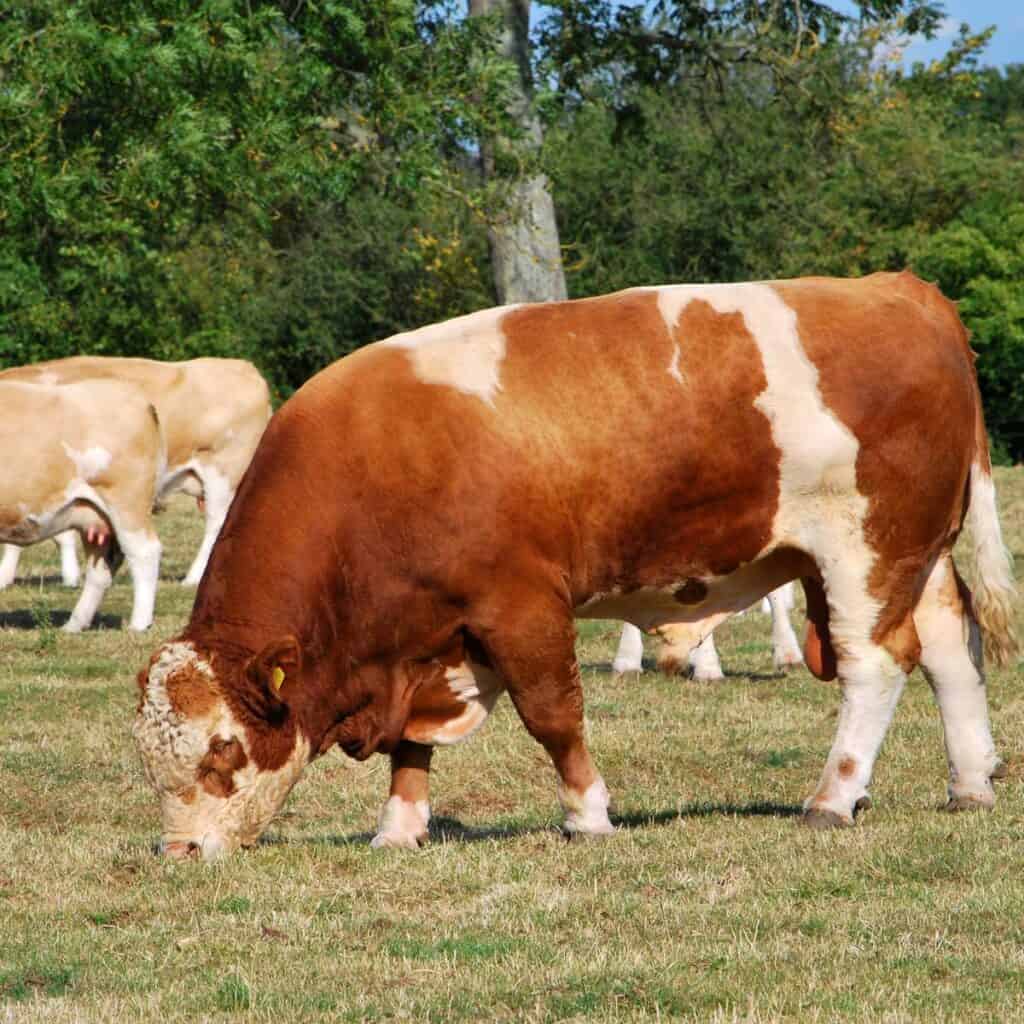
Simmentals (also known as “Swiss Fleckvieh” and “Simmies”) are huge beef animals that were originally bred in the Simme river valley in Switzerland. These large cattle are traditionally red with white markings, but a pureblood variety in North America is all black.
This dual-purpose breed is good for both meat and milk production. A fully grown steer can weigh up to 1,400 pounds (650 kg), and dress out between 50 to 55% edible beef from the hanging weight.
South Poll
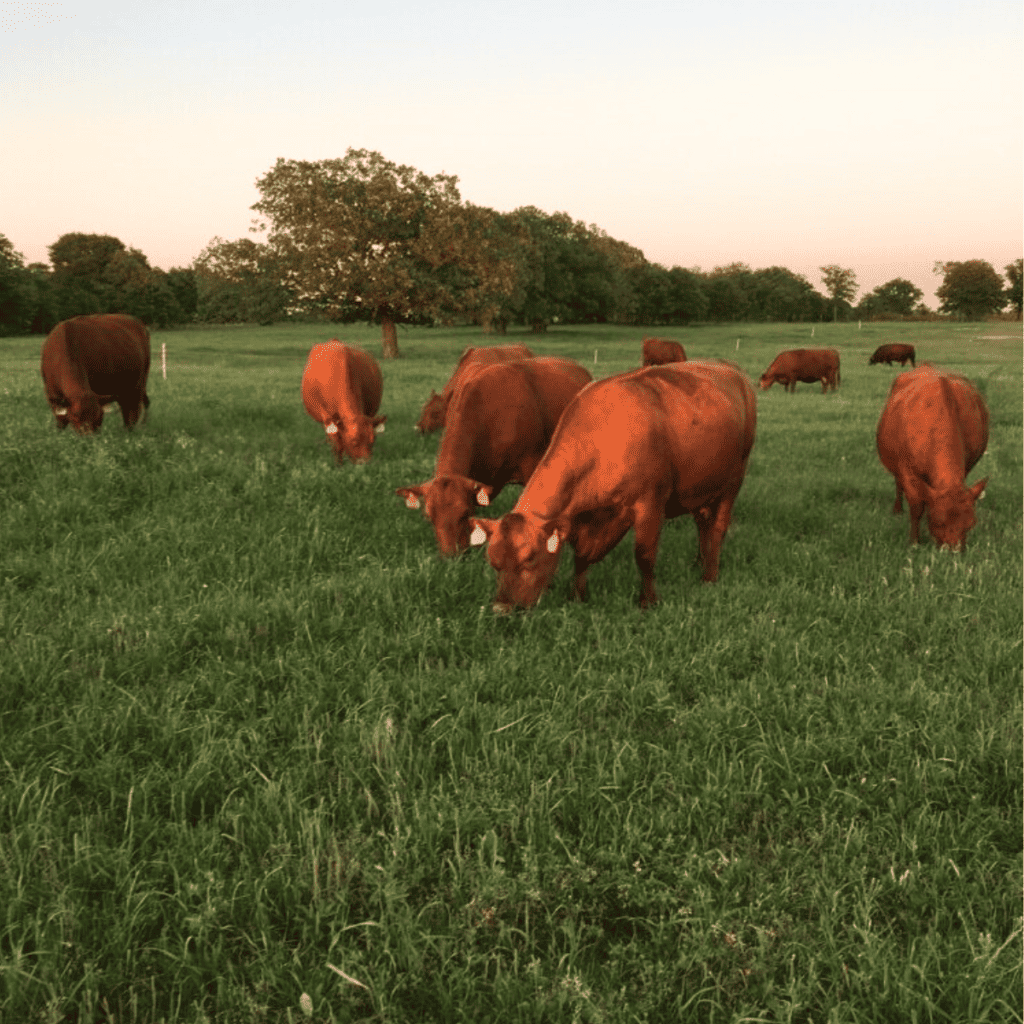
South Poll cattle can be any color, including black; however, full blood South Polls are red, sometimes with a bit of white in their faces. They are a small to medium breed of beef cow, and a fully grown steer can weigh up to 1,200 pounds (550 kg).
Thanks to their slick hide and oil glands, they do well in hot, humid climates, and they generally repel pests. The South Poll breed have genetically equal percentages of Red Angus, Senepol, Hereford, and Barzona.
Additionally, this breed is possibly the best heat-tolerant maternal breed, and efficiently converts grass to tender beef. Thus, mama South Poll cows are gaining popularity to be bred with other bulls (not too large, though) to produce superior offspring yearlings that are well over 1,000 pounds.
Fun Fact: The South Poll breed started being developed in 1989 (by Mr.Teddy Gentry) not far from where I live in central Alabama!
Texas Longhorn
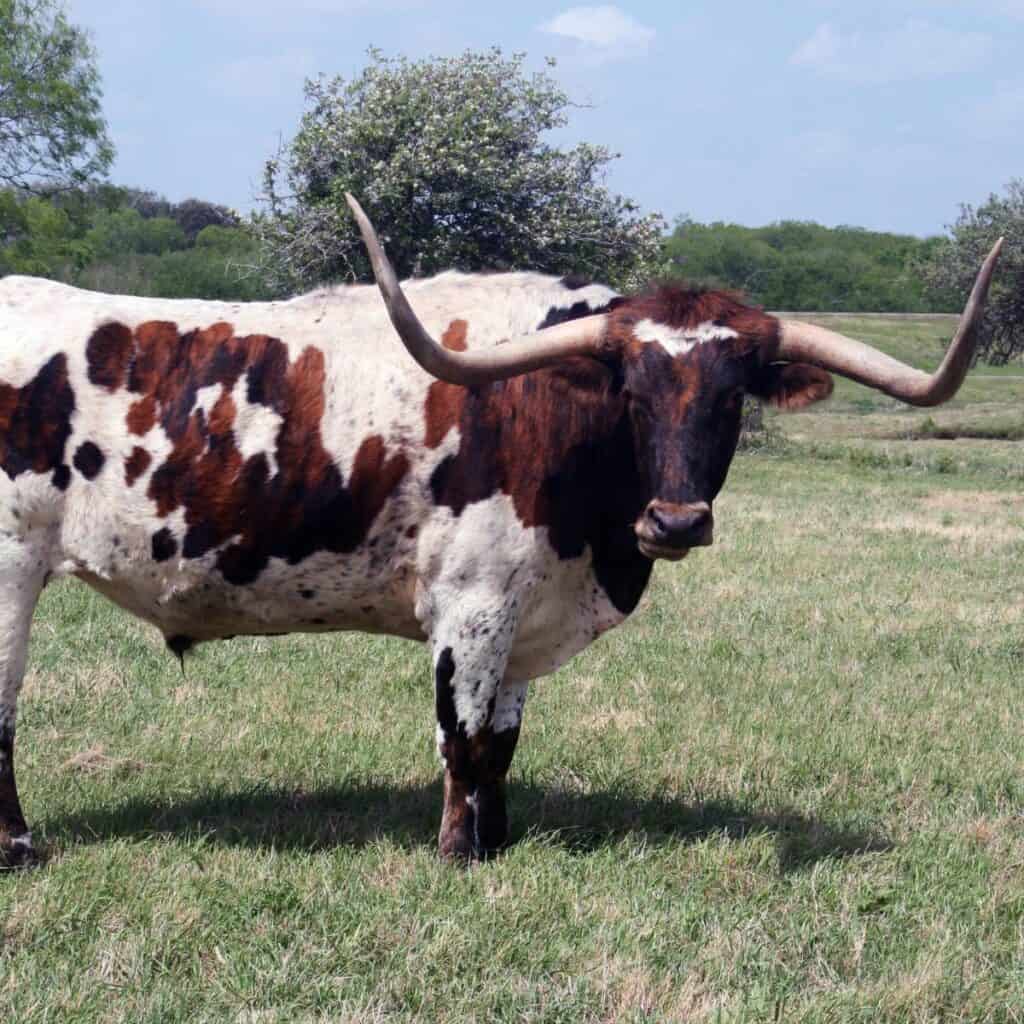
Longhorns have large (scary!) horns, medium frames, and long legs. And no two Longhorns look alike. A fully grown steer can weigh 800 to 1,200 pounds (360 to 550 kg), but he takes twice as long to mature than other beef cow breeds.
Most Longhorns reach maturity in 8 to 10 years, and have horns of 4 feet or less. However, when they reach 15 years old, their horn can span up to 9 feet or more across!
Wagyu
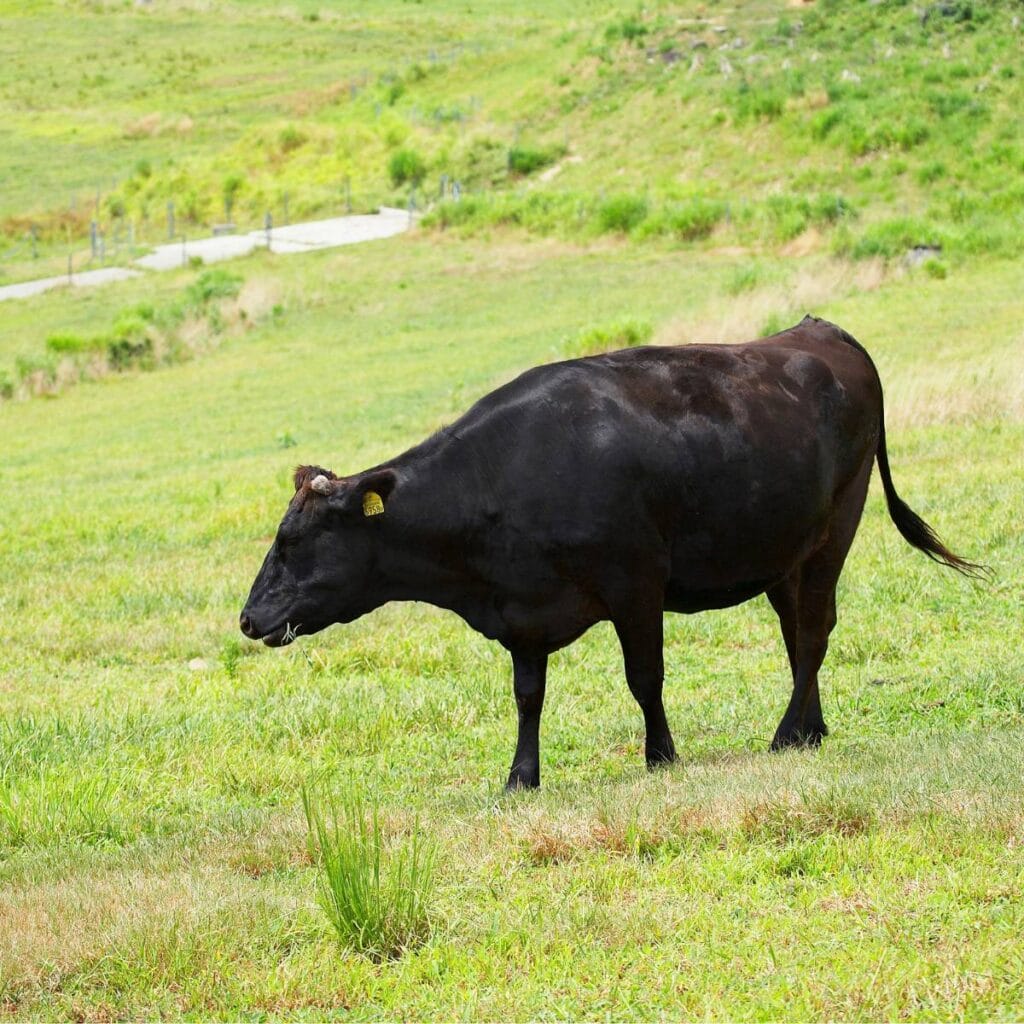
Wagyu are naturally polled with small to medium frames. They are red or black cattle that originate from Japan, where they were traditionally used as draft animals.
Wagyu beef is highly marbled. For this reason, some say that Wagyu beef is one of the most tender cuts of beef, and offers an unrivaled eating experience.
A fully grown steer can weigh between 1,000 to 1,500 pounds (450 to 680 kg), but they take longer to reach that size (generally 30 months).
Word of Caution: Wagyu cattle are not well-suited for grass-fed beef production, so you will need to supplement with a lot of grain so that they grow and finish correctly.
Fun Fact: Kobe beef is a cut of beef from the Tajima strain of Wagyu cattle. Wagyu cattle are historically from Kobe, Japan. However, Kobe beef has been produced in the United States since 1994. The herds were imported and raised here decades earlier. Kobe beef is popular for its rich flavor, juiciness, and tenderness.
What should first-time buyers do when ordering a beef cow?

If this is your first time buying a quarter, half, or whole beef cow from a local farmer or butcher, you should tour the farm where the cows live, tour the butcher shop, and evaluate your available cubic feet of freezer space.
Ensure that you feel comfortable with the way the farmer raises the cows. Likewise, make sure you feel good about how the butcher harvests and processes the cow. Additionally, freezer space is essential for storing a bulk amount of beef, so you want to be sure you can fit a whole cow, half cow, or quarter cow into the space that you have available.
If you don’t have much freezer space, consider ordering a quarter of beef or half beef from a farm so that you can enjoy good beef at a fraction of grocery store prices. You can generally get 20 pounds of beef per cubic foot of freezer space (depending on different cuts of beef).
I go deep into this topic in my blog post How Much Beef Will You Get From a Cow: Breakdown. If you want to learn more, head on over and check it out!
Beef Hanging Weight vs Packaged Weight
Beef hanging weight is the weight of the unchilled carcass after gutting the cow and removing the head, tail, feet, and hide. The packaged weight is the amount after blood and water loss, and removing bones and excess body fat.
A good rough estimate for packaged weight (in edible beef) from the hanging weight is around 50%, but some cow breeds have a higher conversion. Ultimately, the difference between hanging weight and packaged weight is the level of processing and aging.
There’s a good deal of connective tissue and muscle fibers in beef. For best results, you should hang the beef in a cooler with low temperatures for at least a week so that the flavor gets deeper and the muscles get tender.
Beef Rib vs Ribeye
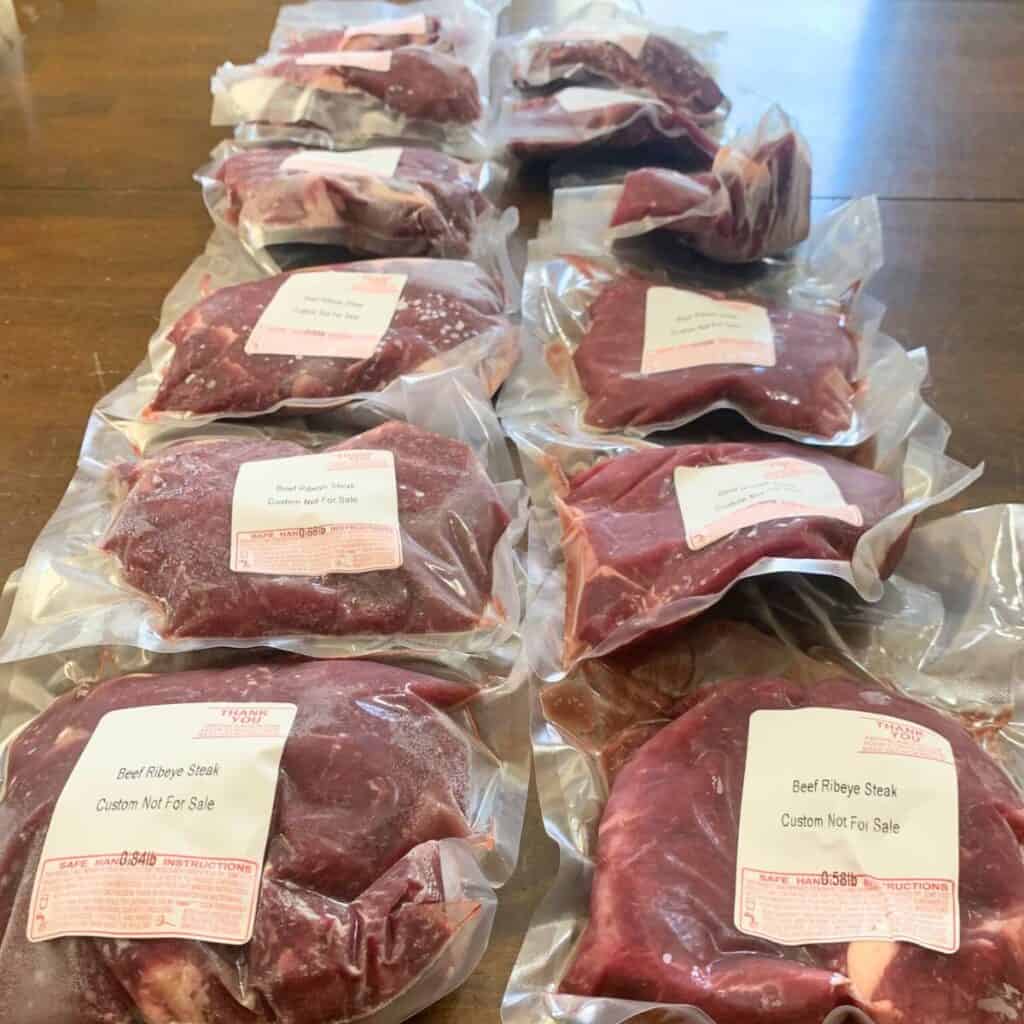
Beef rib (also called “Prime Rib”) is the large rib section of the cow’s primal rib area. A ribeye (also called “rib steak”) is a boneless cut of steak from the prime rib section but ultimately processed into smaller portion cuts.
Strip Steak vs Ribeye
The ribeye and New York strip loin are among the most expensive cuts of steak. While the ribeye is more flavorful, the New York strip steak is more tender.
Best Thickness for Steak
The best thickness for steak is generally 3/4 to 1 inch thick. This will give you juicy, tender, and delicious steaks. However, the best thickness will ultimately depend on your personal preference and the number of steaks you want.
Most people like a steak that is 1 inch thick. For a higher number of steaks, ask for thinner steaks cut 1/2 to 3/4 inches thick. However, if you want juicy steaks, ask for thicker steaks.
How many steaks are in a dairy cow steer? (Our actual numbers.)
The number of steaks you get from an average cow will vary on the cow’s age, frame size, gender, diet, and other factors. You won’t get any steaks from a young dairy cow steer, but may get some from a large, mature bull.
When we took our 1-year-old Holstein dairy cow steer to the butcher, he was very skinny, which is typical of the dairy cow breed.
We took him to the butcher because on the day of our appointment, our 2-year-old Jersey/Angus steer refused to get onto our livestock trailer.
Long story short, his live weight was about 500 pounds (227 kg), and his hanging weight was exactly 256 pounds (116 kg).
I remember the butcher calling me and telling me that there wasn’t enough meat on the bones to make sense to cut steaks, and recommended we get all ground beef instead. So that’s what we got.
When the butcher finished processing, we got back exactly 80 pounds of grass-fed beef, and it was all ground beef.
How many steaks are in a beef cow steer? (Our actual numbers.)
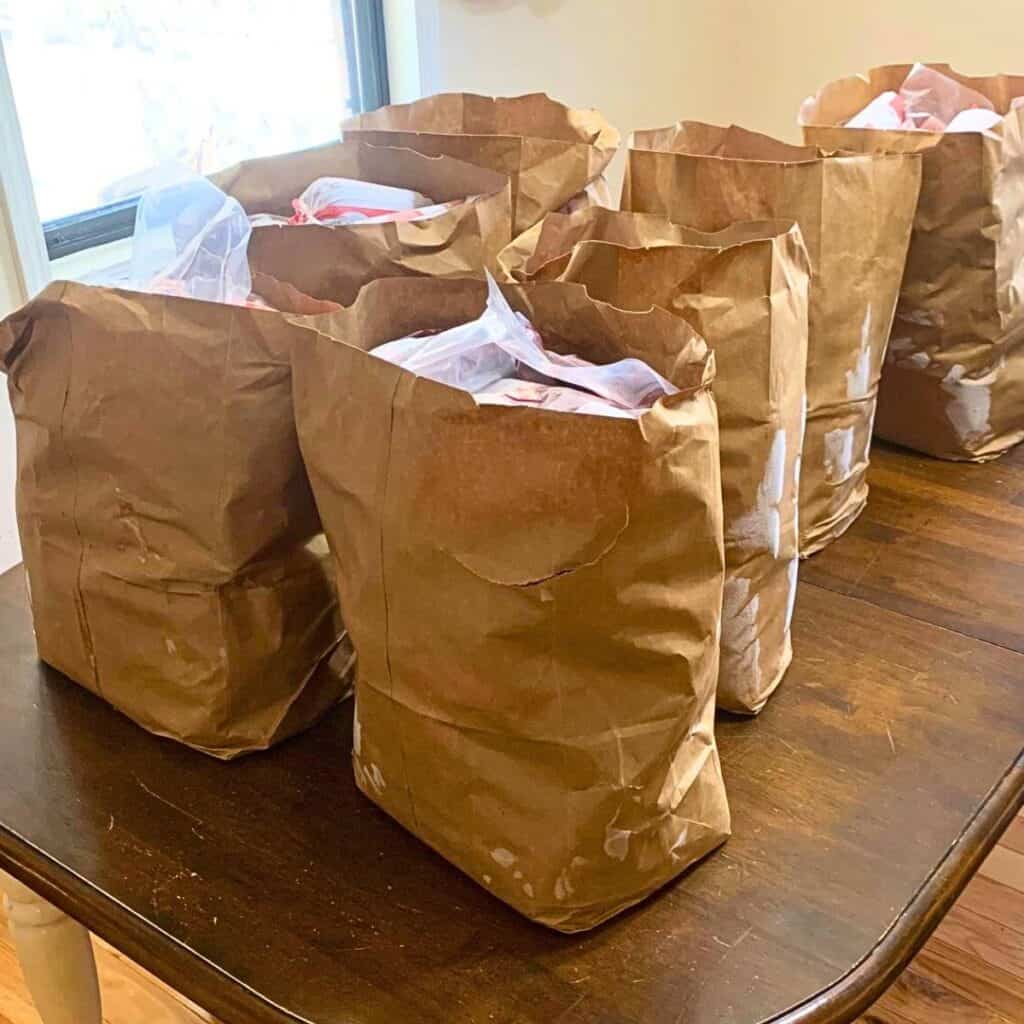
The number of steaks you get from an average cow will vary on the cow’s age, gender, diet, frame size, and other factors. In an average 1,200 pound beef cow steer, you will typically get between 120 and 140 steaks as long as you turn roasts into steaks.
When we took our 2-year-old Jersey/Angus steer to the butcher, he was on the smaller side. You want to breed heifers (female cows that have never calved before) with a small bull. That way, they will have an easier time calving.
Belle was bred to a small black Angus. Thus, our numbers are going to be smaller than the average beef cow steer that comes from good quality breeding.
Our steer weighed 900 pounds (408.2 kg) when we drove him to the butcher. His hanging weight was exactly 455 pounds (206 kg), and he produced 260.58 pounds of beef (118.2 kg). I want to reiterate that heavier cows will generally produce better results.
Cut of Meat
We got back these different cuts of beef from the butcher:
Steaks
We received 26.94 lbs of steak (12 kg).
I like to get my steaks 3/4 to 1-inch thick. But you can choose thinner cuts or thicker cuts. The thicker the cut, the fewer steaks you will receive.
We got back ribeye steaks (also known as “rib eye” steak and “rib-eye” steak), NY strip steaks, T-Bone steaks, sirloin steaks, and filet mignon.
The cuts of steak we received:
- New York strip steak – Six packages with two steaks each, totaling 12 individual steaks.
- t-bone steak – Six packages with two steaks each, totaling 12 steaks.
- filet mignon – Six packages with two steaks each, totaling 12 steaks.
- sirloin steak – Ten packages with one steak each, totaling 10 steaks.
- ribeye steaks – Thirteen packages with two steaks each, totaling 26 steaks.
If you’re doing the math, we got a grand total of 72 steaks.
If you want more steak, you can let your butcher know that you don’t want roasts. The roasts are extremely tender and also make good steaks.
However, since we really like roasts, too, we wanted to split our options and get some steaks and some roasts.
Roasts
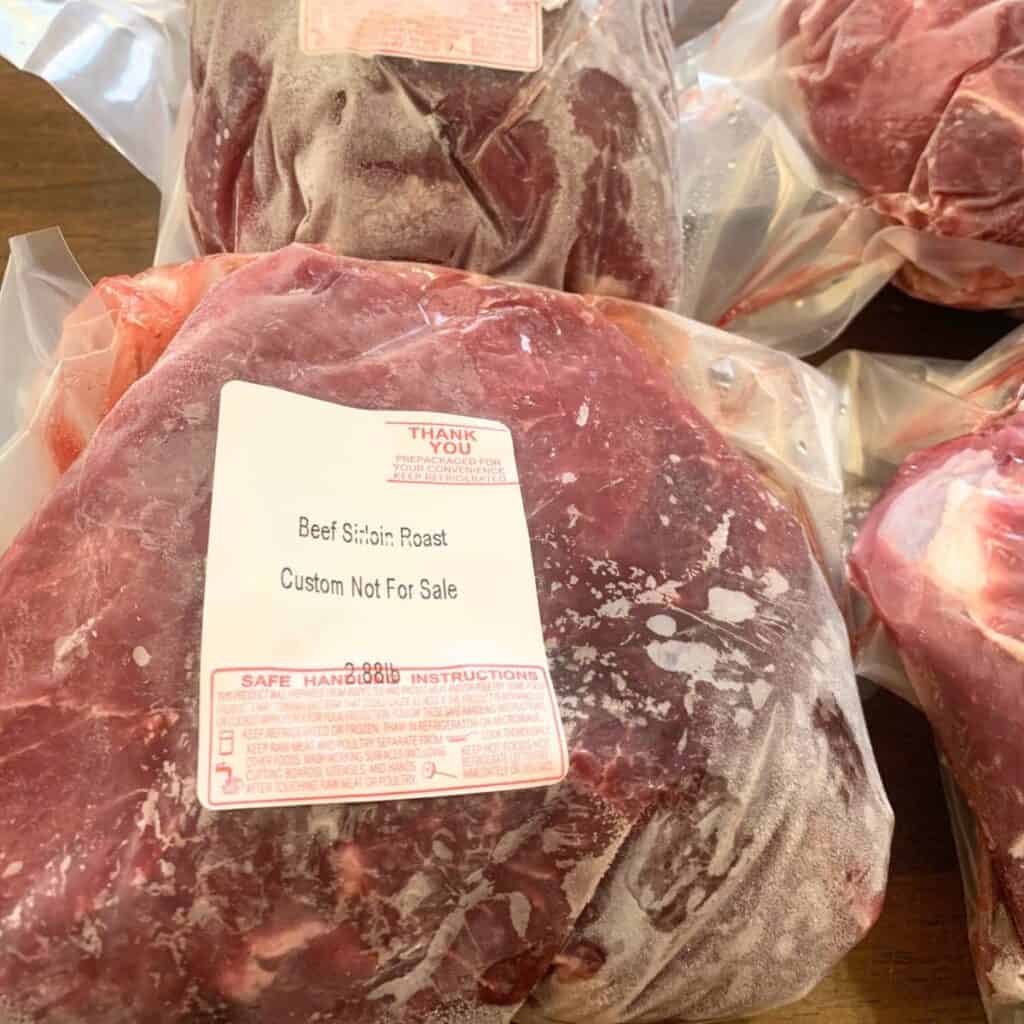
We got back 57.70 lbs of beef (26 kg) roasts.
As mentioned above, if you prefer to have more steaks, you can convert your roasts into tender steaks.
We got back chuck roast, beef brisket, boneless rump roast, shoulder roast, sirloin roast, and the tongue. After roasting the tongue as you would any other roast, simply de-skin the tongue. It’s tender and delicious!
Soup Bones
We got back 16.64 lbs (7.5 kg) of soup bones.
When we raise and harvest steers, I want to be sure we get EVERY bit of usable beef, bones, and fat as we can. Soup bones are great for putting in beans and making your own beef bone broth and beef stock!
Oxtail
We got back 1.18 lbs (0.5 kg) of oxtail bones, which I like to use in oxtail soup.
Ground Beef
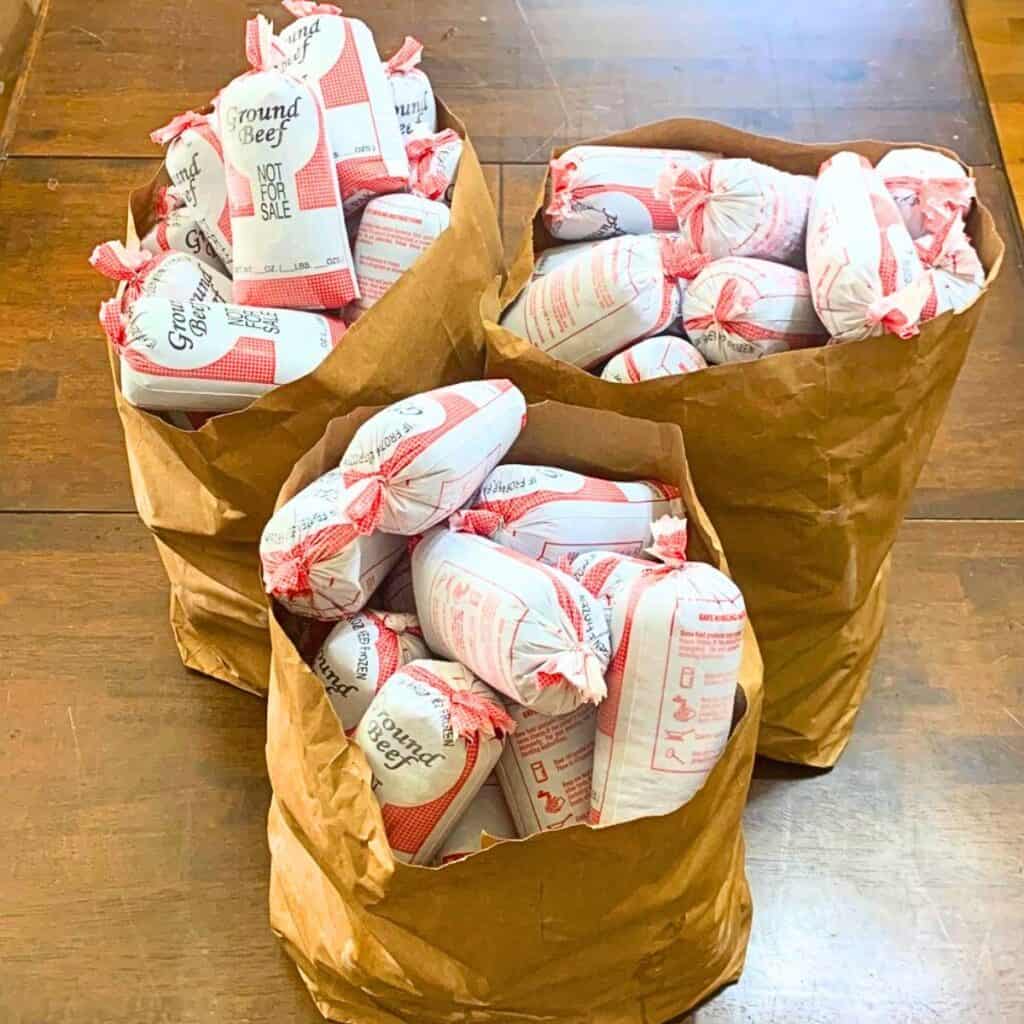
We got back a total of 112 lbs (51 kg) of ground beef. And since the steers were grass-raised and grass-finished, it was lean ground beef.
Beef Tips
We got back 11.06 lbs (5 kg) of beef tips. Beef tips over rice, anyone?
Stew Meat
We got back 10.58 lbs (5 kg) of beef stew meat.
Sometimes I use stew meat exactly as I use steaks. I will marinate them along with steaks and sear them exactly the same way in my cast iron skillet.
That way I don’t have to cut up my kid’s steaks for them! Or not much, anyway. It’s a shortcut I love!
Short Ribs
We got back 11.86 lbs (5.4 kg) of beef short ribs.
Short ribs are from the brisket, chuck, and rib area.
Organ Meats
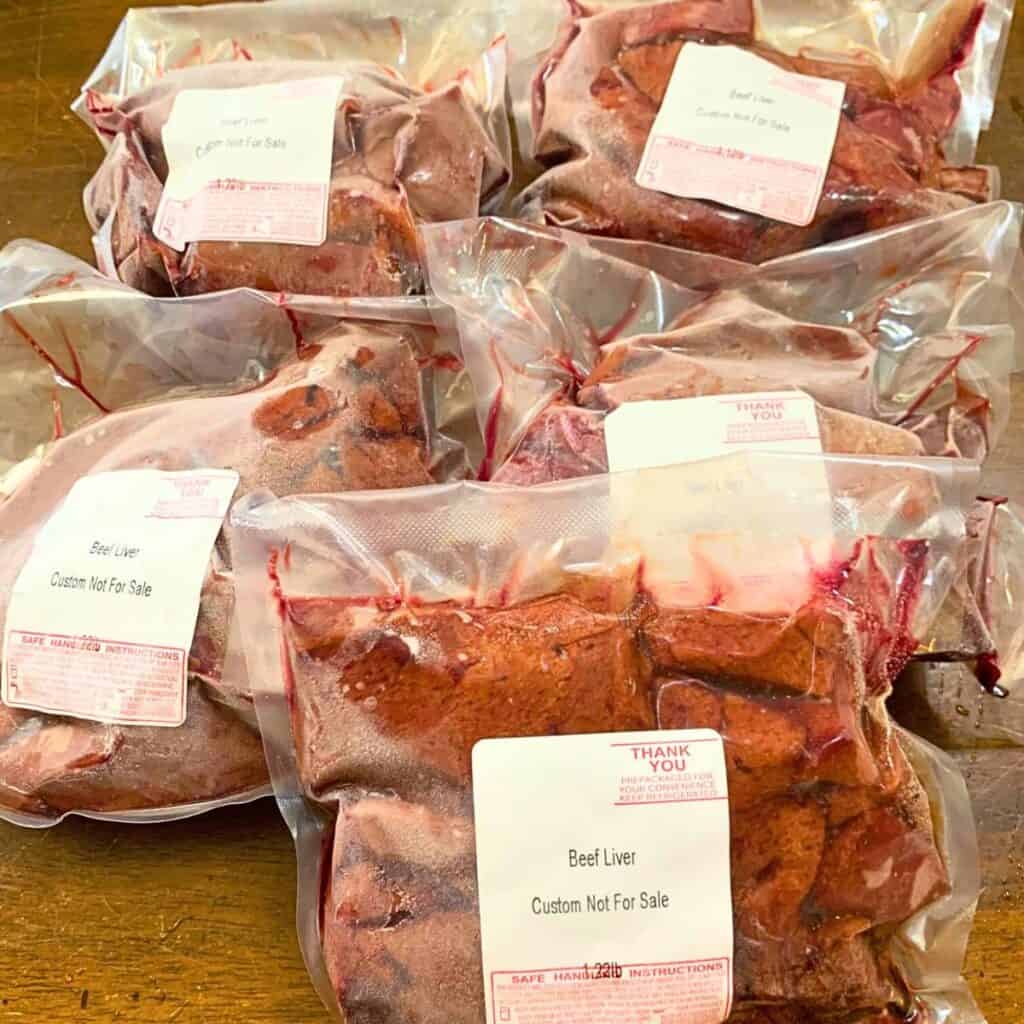
We got back 9.86 lbs (4.5 kg) of organ meat.
Super-foods like organ meats are an important part of a healthy diet.
Fat
We got back 2.76 lbs (1.25 kg) of beef fat.
We always save as much as we possibly can from an animal we raise. Including beef fat!
I will render the grass-fed beef fat into tallow, which is great for everything from homemade body products and soap, to deep-fat frying!
This is the complete list of beef we got back from our butcher.
How much beef do you get from a cow?
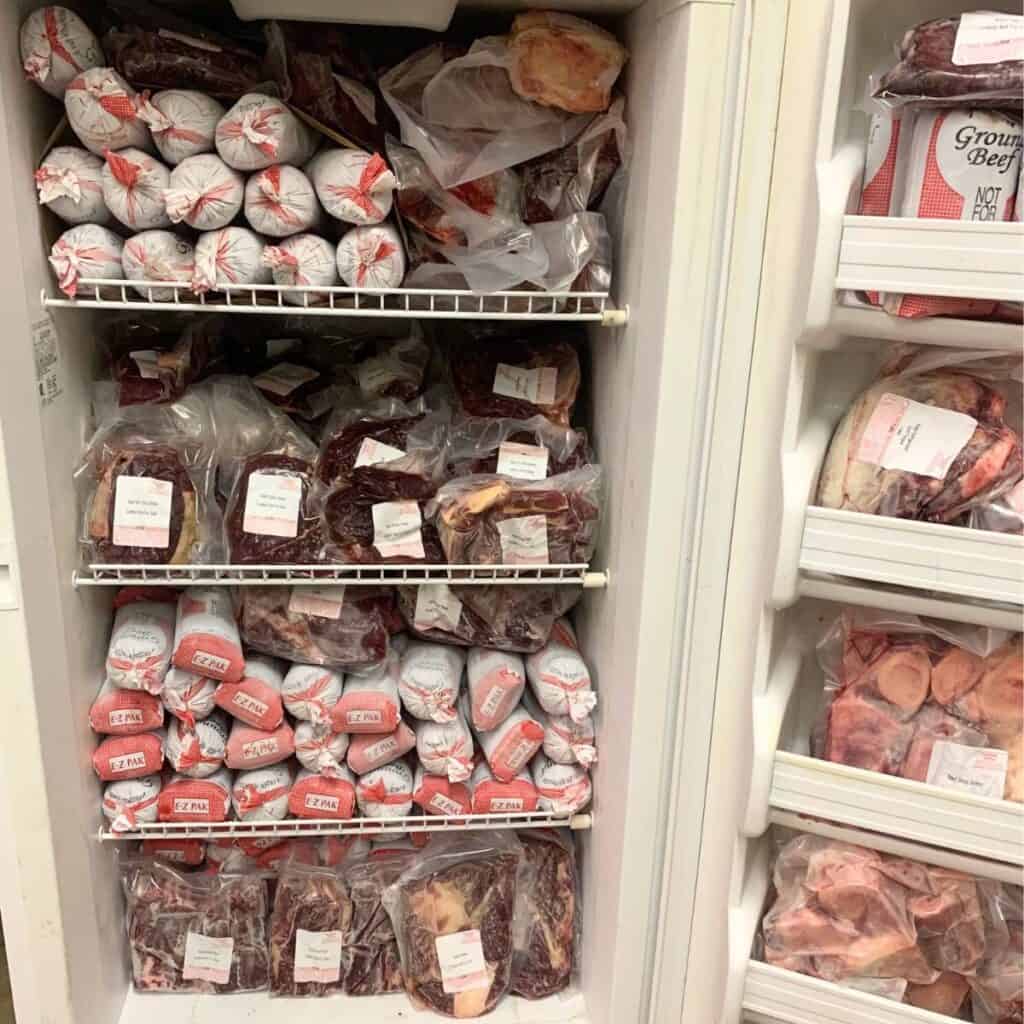
How much beef you get from a single cow will vary based on the cow’s breed, genetic variability within the breed, age, frame size, gender, and diet. A small beef steer with a live weight of 1,000 pounds and hanging weight of 500 pounds will provide roughly 250 pounds of meat, including popular cuts of beef.
If you don’t have space for 250 pounds of beef in your freezer, you can split up the cow with friends. A quarter beef will yield approximately 62 pounds in the same size steer.
If you want specific details including total pounds of different cuts of meat, check out my blog post How Much Beef Will You Get From a Cow: Breakdown where I share how much meat we got from our cow, including a breakdown!
Prime vs Choice vs Select
Beef tenderness, juiciness, and flavor contribute to the overall beef quality grade of prime, choice, and select.
The degree of marbling (fat) is the primary determination of quality grade. Graders evaluate the amount of fat and distribution in the ribeye muscle at the cut surface after the carcass has been ribbed between the 12th and 13th ribs.
Prime carcasses have an abundant amount of fat, choice carcasses have modest fat, and select carcasses have just a slight amount of fat.
Pin It For Later!
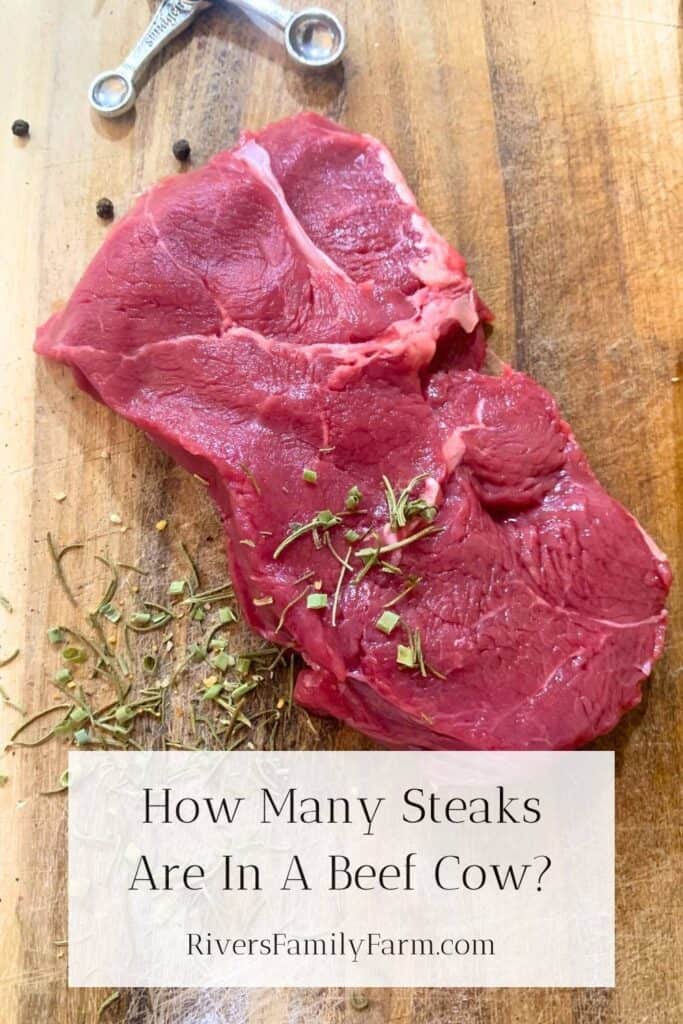
Other Related Posts
The Best Homemade Steak Marinade from Scratch
How Much Beef Will You Get From a Cow: Breakdown

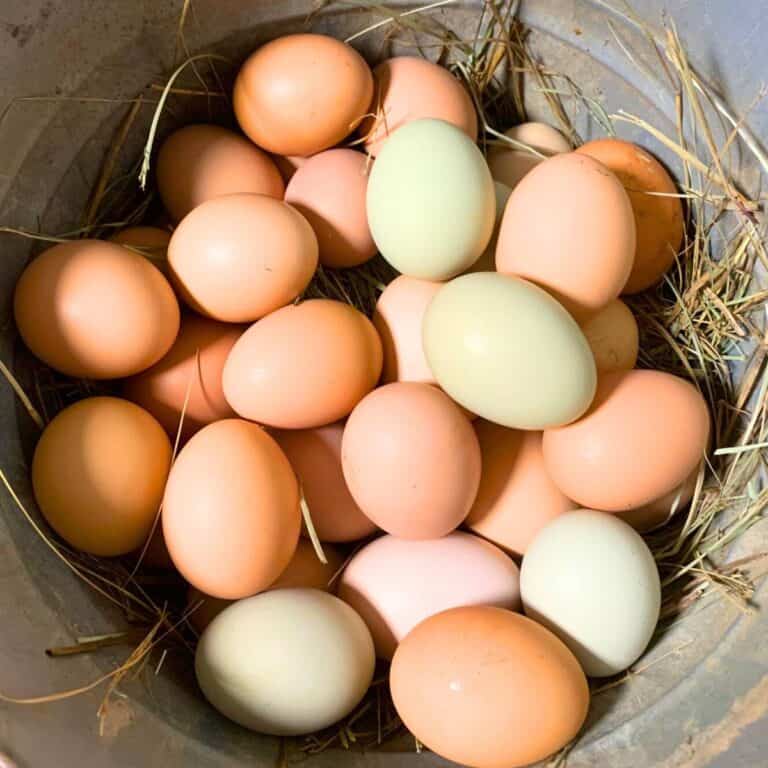
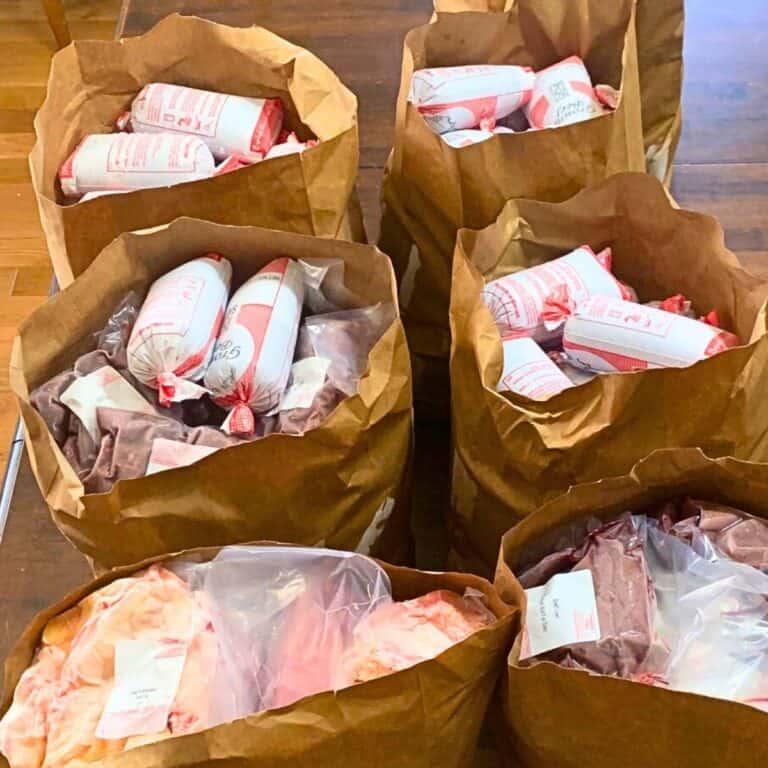

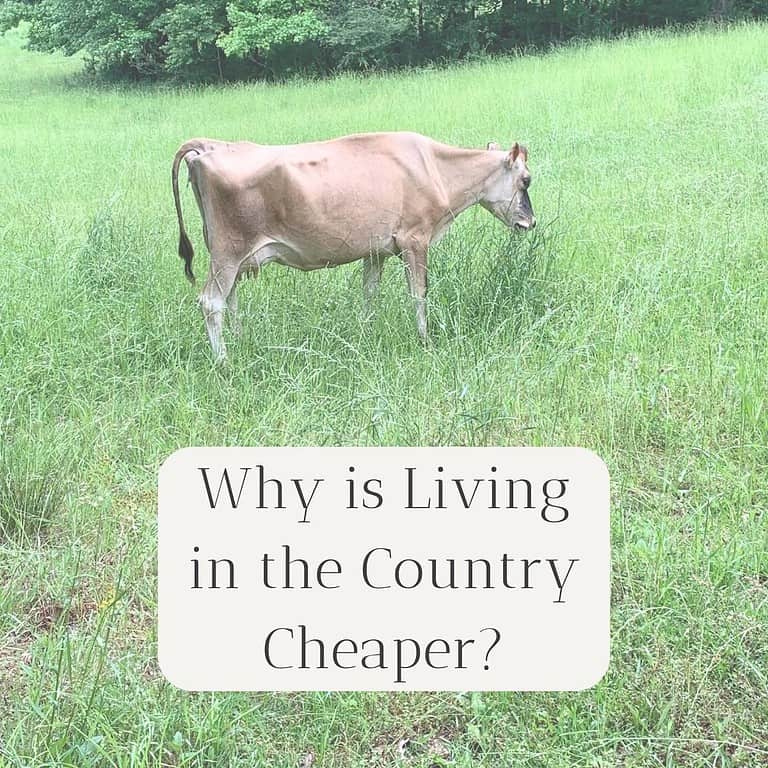
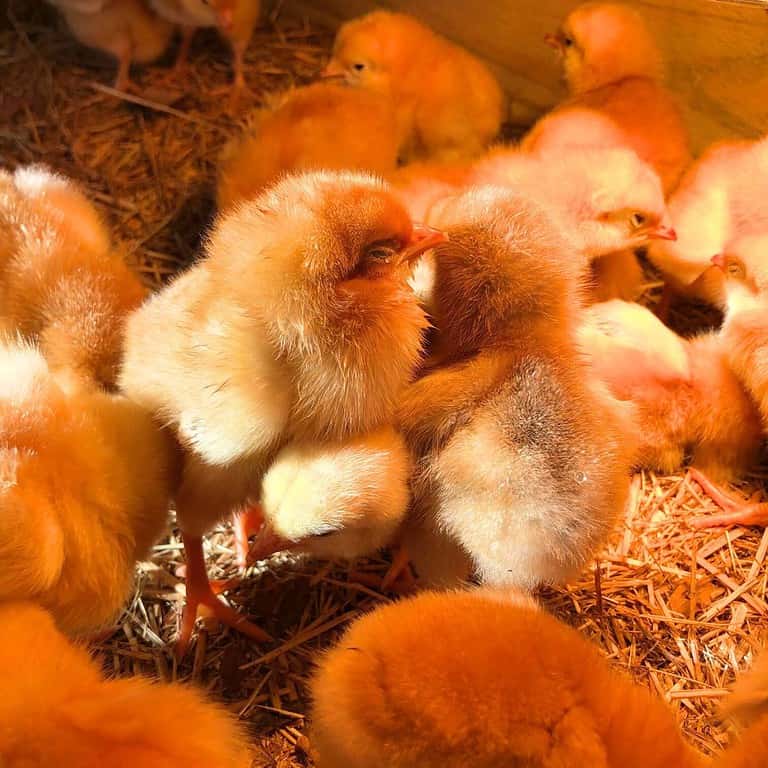
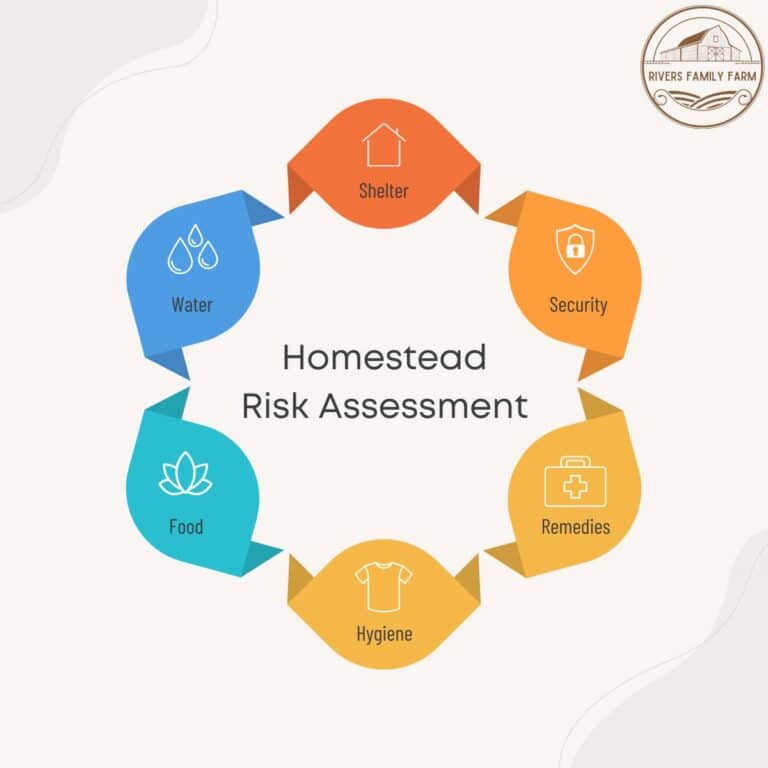
Super helpful information! Thank you for sharing!
I’m glad you found it helpful! You’re very welcome!!
Wow, there is SO MUCH good info in this post. We bought meat from half a cow last summer and the quality is so much better than store bought. Less fat, hamburger meat lasts twice as long in the fridge but need to add a little fat when frying it up. Thanks Rebekah
I absolutely agree! Thanks Nikki!